#micro controller module
Explore tagged Tumblr posts
Text
Foxboro 761cna-bt single station micro controller module - Auto2mation
The Foxboro 761CNA-BT Single Station Micro Controller Module is a reliable and high-performance control solution used in industrial automation systems. It is designed to handle complex control tasks efficiently, offering accurate monitoring and fast response. Ideal for single-station applications, this module ensures stable operation and helps improve system productivity. Known for its durability and easy integration, it is widely used in process control industries. At Auto2mation, we provide genuine Foxboro automation parts with expert support. The 761CNA-BT module is a perfect choice for dependable and cost-effective process control. Contact us today to learn more or place your order.
#industrial automation#industrial equipment#industrial spare parts#industrial#automation#industrial and marine automation#industrial parts supplier#industrial innovation#automation solutions#Marine Automation#marine equipment#marine spare parts#auto2mation#equipment#automation equipment#industrial automation applications#Foxboro#micro controller module
0 notes
Text
vital signs
~2.2k words, premed!zayne x black!fem!premed!reader, college au, fluff, SLOW burn, smut, semi-proofread, oral (f receiving), soft & slow sex, a little dirty talk, wouldn’t be me without yearning, micro-aggression mentions if you squint, black reader intended, minors and ageless blogs do not interact, i WILL block you!!
a/n: just graduated college & also prepping to apply to medical school so this was kind of just self indulgent, i love this one though :)

entry 1: initial observations
date: week 1
course: anatomy & physiology
you were late. first day of spring semester, anatomy and physiology, and your phone’s gps led you in a circle twice before you stumbled into the lecture hall, breathless and sweating out your edge control. eyes turned as you entered the room, the only seat left was beside someone with impossibly straight posture, dark clothes pressed so clean you could see your reflection in those buttons.
you dropped into the chair, whispering a quick “hi.”
no reply, just the sound of his pen gliding over a yellow legal pad with perfect precision as he stared intensely at the lecture.
you snuck a glance. sharp jawline, lips pressed into a line, brows so still they looked sculpted, like expression never bothered to land there. he looked like he woke up every morning already two hours ahead of the world.
oh, one of those, you thought. probably thinks i’m not serious..now being in your junior year of undergrad, you’ve had your fair share of “gunner” pre-med students at this point, nothing a surprise anymore.
you sat a little taller anyway. matching energy.
notes:
he probably thinks i’m not serious.
(so now i have to be.)

entry 2: contact under sterile conditions date: week 4 — dissection module
course: a & p
weeks passed, you weren’t surprised when no one wanted to partner with zayne for the dissection module. his vibe was… clinical. unapproachable. maybe even intimidating.
you volunteered, not to prove a point, okay, maybe a little.
he didn’t look at you when you suited up beside him, just handed you gloves. “try not to cut too deep,” he murmured, tone cool, eyes on the cadaver like it was a puzzle to be solved.
when your scalpel hesitated mid-air, his hand moved to yours, steady, gloved, and warm through the latex. he didn’t take over. just guided, a subtle nudge of reassurance rather than correction.
his voice, usually so clipped, dropped just enough to feel different. “you’ve got a steady hand, don’t overthink it.”
a compliment?
your brain lagged for a second. you glanced at him, expecting that same blank focus, but for the first time, his face shifted. barley, but enough for you to notice.
notes:caught him looking longer than necessary :p
still expressionless but not unreadable.almost like curiosity.
conclusion:hand contact counts as data.so does the way he said don’t overthink it.
(too late.)

entry 3: passive proximity
date: mid-semester
location: third floor library, table by the window
you started sitting across from him at the library, not intentionally at first, then, maybe a little intentionally.
he never said no. never said much at all. but he always shifted his laptop slightly, making space for you. you’d eventually find your pens migrated into his space, your outlines somehow shared, annotated in his unmistakably neat print.
notes:i never asked to share notes.he never asked to stop.
it’s the quietest collaboration i’ve ever had.

entry 4: study buddies
date: week 8 — post study group
location: study room 4C
a study group was your idea. you liked how people bounced off each other, how information got clarified when it had to be said out loud. zayne stayed behind after everyone else left.
you were packing your notes when you heard him say, “you explain glycolysis like you’ve lived it.”
you turned, caught off-guard. “is that a compliment or…?”
he looked directly at you, that cool mask still firmly in place. “it means i remember it when you say it. that’s not normal for me.”
your breath caught in your throat. you smiled, soft and genuine, pushing your prescription glasses up to your face. he looked down, and for once, you thought he might be the nervous one.
notes:he remembers what i say.even when he says nothing at all.
that was definitely a compliment ;)

entry 5: fieldwork — collaboration
daye: week 10 — student clinic volunteering
location: pediatric wing, room 3
the student clinic had its own kind of quiet chaos, sick kids, anxious parents, paperwork piling up while the waiting room buzzed low and tense. but you liked it. it made everything you were working toward feel tangible, grounded.
you’d heard rumors that zayne had been volunteering here for months before classes even started, quietly showing up early, staying late, always just… there. you never asked why.
the boy in room 3 was maybe six, trembling as he tucked himself behind his mother’s legs. you crouched down, voice soft and steady, explaining the procedure in the gentlest way you knew how. but he only clung tighter, eyes wide with fear.
zayne stepped in, wordless at first, kneeling beside you.
“she’s very good,” he said quietly, addressing the boy. “she helped me when i didn’t know what i was doing, you can trust her.”
you turned toward him, surprised by how calm his voice sounded, not cold, just certain. something fluttered in your chest. you’d never seen him vouch for anyone, yet here he was, offering his credibility like it cost him nothing.
like trusting you was the most obvious choice in the world.
notes: subject’s trust is not given lightly.trusting me felt obvious to him. coldness thawing under microscope <3

entry 6: unexpected shelter
date: week 12 — post-clinic
location: campus walkway, outside dorm
it poured the second you stepped outside. your hoodie adorning the school’s logo was no match for it. you were about to bolt when an umbrella opened over your head. zayne stood beside you, holding it without a word.
he didn’t offer his arm, didn’t make small talk, just walked beside you, perfectly poised, sharing the umbrella like it was a contract.
at your door, you turned to say thanks. but your words caught in your throat. rain clung to his lashes. his eyes dipped to your lips for a breath of a second. then he was gone.
and you were left wondering if you’d imagined it.

entry 7: behavioral assessment— mock interview
date: week 14
location: reserved study room
you’d spent hours preparing for this, rehearsing answers, perfecting your tone, making sure your confidence felt real and unshakable.
today, you wore your best blazer, the one that made you feel like you could take on the world. across the table, zayne sat composed, unreadable as ever, his eyes sharp and focused. not a hint of a smile, not a single blink to give you away, but beneath the surface, something quietly stirred. his foot tapped just once, twice, barely noticeable, like he was keeping a secret locked inside.
afterwards, you laughed as you stepped out the door. “so? did i pass your standard of cold professionalism?”
he tilted his head, eyes steady. “you’ll get into medical school before i do.”
you stopped in your tracks. “jealous?”you replied teasingly, poling your lip out as you spoke.
he side-eyed you, looking at you like the word was foreign. “i don’t usually admire people.” he replied courtly before speeding up his walk, leaving you to chase after him.
notes :
cold professionalism + light teasing = suspiciously warm vibes.
“i don’t usually admire people” = code for “i’m secretly impressed, don’t tell anyone.”

entry 8: stairwell breakdown
date: tuesday before finals
location: stairwell outside lecture hall
it all came crashing down the tuesday before finals. you found yourself slumped on the cold stairwell, shoulders trembling, not from the chill, but from the weight pressing down inside your chest. the flashcards in your hands blurred into indecipherable shapes, words slipping through your tired mind like water through fingers. doubt gnawed relentlessly at you, maybe you’re not cut out for this. maybe everyone else belongs here more than you do. the exhaustion wasn’t just physical anymore, it was the heavy, suffocating ache of feeling like an outsider follwing your own dream.
footsteps approached, you didn’t look up, but then a protein bar appeared in your lap, and a blonde espresso caramel macchiato was placed beside you.
zayne sat beside you without a word. your breathing slowed, anchored by his quiet presence.
you finally exhaled, the words slipping out like something you’d been holding in for too long. “i don’t think i’m good enough for this.”
he turned to you then, something gentler in his eyes, barely visible, but there.
“you’re one of the best,” he said, voice quiet but firm. “the rest of us are just trying to keep up. including me.”
your heart clenched. you hadn’t realized how badly you needed to hear it until that moment how much of yourself had been tied up in proving something you were already becoming.
you sniffed, managing a weak laugh as you nudged his shoulder with yours. “bruh, you’re literally top of every class.”
he gave a small shrug, the corner of his mouth twitching, almost a smile. “doesn’t mean i’m not chasing you.”

entry 9: confession protocol
date: last day of semester
location: a&p lab
it was the final lab, leaving just you and zayne finishing clean-up. the air between you felt too charged to ignore.
you were hanging up your lab coat when you heard him say it, quiet, controlled, like every word was chosen.
“i’m not good at this.”
you turned. “at what?”
his eyes met yours. unflinching. vulnerable.
“at pretending i don’t think about you all the time.”
your breath hitched. everything you’d suppressed all semester while focusing on classes rose to the surface like steam from an open wound.
say something, say anything, you thought.
all you did was step closer.

entry 10: final
date: last day of semester
location: a&p lab
you reached for his hand first, trembling. zayne met you halfway. his palm was cold, steady, reverent.
he pulled you in with slow gravity, like he’d been holding back the entire semester. you leaned in. so did he.
when your lips met, it wasn’t desperate, it was inevitable.
and for the first time, he let the softness show. just for you.
it started with that kiss that tasted like everything you’d held back.
zayne’s hands were steady as always, but something in them had shifted, urgency pulsing just beneath the surface. the lab had been cleaned, the lights off. it was supposed to be over. but the way he looked at you made it clear something unfinished remained between you.
he kissed you like he’d been memorizing the thought of it for weeks. polished hands slid along your jaw, holding you still not possessive, but deliberate. his thumb brushed your cheekbone like you were fragile. you weren’t, and you both knew that, but the softness made your knees weaken all the same.
when he pulled back, his voice was low, controlled. but rough around the edges.
“tell me if you want me to stop.”
you didn’t. you couldn’t. you only nodded.
zayne guided you backwards carefully, always carefully, until you bumped into the edge of a table. he didn’t rush. his fingertips skimmed your hips like he was reading anatomy again, like every curve had to be relearned under his hands. his lips followed, tracing your neck with patient admiration.
you breathed out, voice barely a whisper. “do you always take this long?”
a faint smile attached to your hip. his hands tightened just enough to make your breath catch and make you let out a small moan.
“i don’t rush what i care about.”
the air between you tightened. clothes fell away in slow layers, peeled back like secrets. every time his fingers touched bare skin, it felt like a vow, silent and absolute. he never fumbled. every motion had purpose. every kiss landed like it was meant to stay.
and when his mouth moved lower down your chest, across your stomach you felt it in the ache in your cunt. he kissed like he was studying you. still obsessed with knowing everything beneath the surface.
“look at me,” he said, voice like silk over heat.
the moment his tongue touched you, your body arched in response. he held your thighs firm, anchoring you while he worshiped you with precision. no hesitation, no wasted movement. just slow, focused attention like you were the only thing in the world that mattered.
you came on his face feeling your entire body melting, his name breaking from your lips before you could stop it. he covered your mouth as he worked you down from your high. zayne rose, kissing you again, tasting your own juices against his tongue.
“you—” you tried to speak, dazed. “you’re not what i expected.”
his eyes locked on yours, dark with everything he hadn’t said.
“i’m exactly what i want to be. for you.” he stated, removing his erection from the neatly tailored pants.
he entered you slow, controlled, deep, reverent. and stayed close, forehead resting against yours as your bodies found rhythm. each thrust was deliberate, more emotional than physical. not fast, not rough, just intense.
your clung to him as he murmured things you barely caught. “so beautiful.” “been dreaming of this.” “mine.”
when you came again, eyes rolling back, he followed, shuddering against you as he pulled out with a broken exhale that sounded like surrender.
you laid there after, hearts syncing in the dark of the lab. zayne brushed damp curls from your forehead. for once, his voice held no chill. just quiet awe.
“you undo me.”
you smiled, eyes heavy, heart full.
“good.”

~gg ♡
#lads#black mc#zayne x non mc#loveanddeepspace#love and deep space#zayne love and deepspace#dr zayne#lads zayne#lnds zayne#zayne x reader#zayne x you#l&ds zayne#doctor zayne#zayne smut#zayne x black reader#zayne x black mc#black fanfiction#black y/n#black fanfic writer
57 notes
·
View notes
Text
Specimen Fidelity—part 1
The Emmrook Ex Machina AU I've been having fever dreams about that was meant to be a one-shot but became longer.
Below or on ao3

He does not look at her name.
There it is, lazily typed, folded into a file gone soft at the edges from months of inattention, lying face down on his knees like a dog trained too well. He avoids it not out of sentiment, but etiquette, an old-fashioned belief that glancing at her then would ruin her now. Names belong to people. She is no longer precisely that. She is what remains.
Whoever she was, she has long since fled: first in that gray-blue moment of asphyxia, then more decisively in the cold that stole the last residue of her from the body. What’s left is a kind of exquisite vacancy. Smooth skin. Good teeth. Organs intact enough to transplant. The mind, no, the brain, spoiled a little at the edges, but not so much as to ruin the structure.
She is a husk now. That is the term they use, though they rarely say it aloud. A shell. A vessel. Something deserted.
She signed herself away. That part is clear. It’s all in the documents, those long, soporific forms in which the promise of scientific legacy is tucked between clauses about bodily integrity and postmortem jurisdiction. Most don't read them. Most don’t even think it matters. The living are not very skilled at imagining their own absence.
Especially the young.
They sign with the breeziness of actors autographing headshots. I’ll take the cheque, they think. I’ll pay the rent, I’ll buy the coat, I’ll order the steak. Later I’ll find a job, I’ll bounce back, I’ll buy my way out of the contract before the worst can happen. It's a kind of wager, really. The arrogance of survival.
He can hear it in his mind, the imagined laughter of someone like her. The scoffing chuckle over drinks, the way they must have mocked the lab, the men with their hollow smiles and printed waivers. They sign: page after page, cheerful and hungover, in flats with chipped tiles and borrowed furniture.
But suddenly... one stairwell too many, one needle too deep, one heartbeat too late... and the contract holds.
Now here she is.
Delivered on time. Labeled. Compliant. A body not quite empty, just misfiled. The voice is gone, yes, but the throat remains. The thoughts have fled, but the folds of the brain are still there, those secret ridges where language once rested. And she, this woman whose name he won’t speak, she has become something else entirely.
He watches the machines go about their work. The cutting begins as it always does: a gliding motion of the primary manipulator, blade embedded in a flexible armature, slipping through waxy flesh. No blood. Only a thin seep of fluid, the consistency of glycerin, rising sluggishly before being vacuumed away by the suction module, its long, tubing mouth issuing that same damp, peristaltic wheeze he has never grown used to. It sounds like thirst.
"I am sure you’ve heard this one before: most men only get flowers at their funerals. But did you know, my dear, that most women, around seventy-eight percent if I’m not misremembering, buy flowers for themselves?"
He likes speaking during procedures. Likes the noise of it, the rhythm. Talking to them or at them or near them, it hardly matters. It eases the dryness in his mouth. Gives the whole thing a sort of polite framing. A dinner-table shape to something otherwise too clinical. His fingers tap his knee in a syncopated pattern and he smiles vaguely, not at her face, not even at her hand, but somewhere around her shoulder. A safe and meaningless place.
A secondary probe slips beneath the skin, separating layers of fascia with controlled bursts of micro-vibration. He hears the slight crackle as connective tissue parts. The machine pauses, adjusts its angle, then delves deeper. Clamps lower, legs of steel spidered out over the abdominal cavity, pinning the body in place as the cranial unit descends and begins its scan of the brain’s remnants.
"Isn’t that strange? Or no, not strange. Lovely. Quietly, beautifully mad. Not that they admit it. Society, in its infinite pettiness, prefers to call it vanity. Or melodrama. Or, worse, manipulation. As though a daffodil were a loaded gesture. But I would think..."
Inside, her organs are removed one by one. Some manually extracted by the manipulator's grip, others liquefied and drawn into containment vessels by enzymatic breakdown. The liver resists, slightly distended, and when it is finally torn free, there’s a soft tearing, like the peeling of a fruit too long on the vine. The stomach follows, collapsed inward, and is discarded.
"I think," he resumes the thought, “everyone ought to have flowers. At least once. Long before they are laid into the earth.”
His hands tremble.
Her chest is fitted with a conductive mesh threaded along the ribs and stitched into the pericardium. It serves both to anchor and to insulate, to distribute electric current like a nervous system’s counterfeit. The lungs, emptied and resealed, are installed more for balance than function. She will not need them, but she must carry them. A hollow woman must still appear full.
He turns away before they lift the skullcap. He’s seen the procedure often, and though routine, it never loses its quiet revulsion. The oscillating cranial saw, a precision instrument with a diamond-edged blade, traces a semicircular line just behind the frontal hairline. There is no sound but a slight vibration in the table. The parietal bone is lifted with a vacuum-coupled retractor, set delicately on a stainless steel tray lined with absorbent gauze. Beneath it, the brain is pale, slack with cellular death. No swelling, no hemorrhage, just the even, irreversible collapse that comes with hypoxia and time. The neural surface is intact but inert, like a concert hall with the power cut.
"You know," he continues, conversational now, "I read once that tulips keep growing even after they’re cut. You place them in a vase, and still they reach. As if they haven’t been told it’s over."
The interface deploys next. Each filament ends in a microelectrode calibrated to detect electrical activity at the cortical level. Here, though, they detect nothing. There are no residual signals. No memory engrams. No last flickers of self. The tissue is mechanically viable, metabolically inert. It is, simply, a structure: the scaffolding on which something else will be built.
The mesh flexes, adheres, anchors to the anchoring points he marked the night before. The feedback lights blink green. A connection has been established. Not to thought, not to memory, but to matter. The net is not there to communicate. It is there to replace.
This is not restoration. There is nothing to restore. This is a stage being set for a different play, one with a different actor, a different script.
"Violets, conversely, die within hours. Collapse, really. All that delicacy, all that scent, and for what? They’re barely present before they begin to decay. There’s something painfully honest about that."
He lifts his cup, finds the tea cold, sets it down again. On the screen, a prompt: Ocular Selection Pending.
He scrolls. Rows of artificial irises flicker by. Too bright, too false, too simple. He selects a soft blue, nearly grey, and adds a fleck of amber in the lower quadrant. It is not recorded. He will not mention it in his notes. It is for him alone, a private indulgence. Something to notice when she blinks at him for the first time.
Hours pass.
When the machines withdraw, she lies there in complete stillness, as though nothing had ever been done. The suture down the center of her chest is closed. Her body has been dried, polished, posed. Her right wrist bears a subtle bulge, titanium beneath the skin where the bone had shattered during transport. The appendectomy scar remains, faint and healed. It must have happened years ago.
He studies her.
Her body is pristine. Correct. Balanced. The skin nearly translucent in places, especially along the ribs. The breasts are soft from preservation, neither lewd nor modest, simply present. Her hips have shifted slightly, the left side settled deeper into the table’s cushion. He looks lower, then stops himself, heat blooming unwanted in his cheeks. It is not appropriate. He is a scientist. She is not to be gazed at in this way.
She is not alive.
Not yet.
"I would have brought you flowers," he says, not entirely to her, not entirely to himself. "Had I known who you were. Had I thought it would matter."
There is, he tells himself, an art to arranging the dead. He is not an artist. But he practices. He cannot give her back her life. He can give her life but not her life. This is not resurrection. This is not a birth. This is creating someone from scratch to see if they can live inside a body that does not decay. Maybe... maybe he'll lie on this very table himself one day, once his project is complete, once it is successful, and the dread will lift from him. He would not have to die.
He cannot give her memory. That, he knows. He cannot return to her the shape of her thoughts, the rhythm with which she once folded her hands, or the cruelty or kindness she may have shown to strangers. That is gone, dissolved in the long, low hush of brain death. But beauty, yes, beauty he can offer. Beauty he can construct. A curated, constructed beauty, yes, but tenderly so. She already has the eyes, the ones he designed quietly at his desk, sifting through hundreds of pigment matrices until one shade caught him unaware.
She lies there now, not lifeless exactly, but paused, awaiting further instruction. He watches her the way a painter might consider a canvas that has just begun to betray its potential.
The blush is the first indulgence. Not slapped on, not superficial, but embedded, injected, coaxed. A slow infusion of heat-responsive pigment beneath the skin of her cheeks, subtle enough to imitate feeling without suggesting parody. It will deepen, just slightly, when she speaks, when she tilts her head. He programs no direct cause. He wants it to feel spontaneous. A coincidence of color. Her lips receive the same attention. No synthetic gloss, no caricature. Just a breath of warmth, a rose too tired to bloom fully. Something like youth, like innocence.
He notices the burn under her chin, a small patch of healed skin, imperfectly textured, with the agitated scratches of someone trying not to think about discomfort. She must have touched it constantly. Picked at it. A private misery. He removes it. The laser hums once, and the skin forgets it ever suffered.
Her eyelashes are uneven. The right eye especially, sparser near the outer edge. He notes the asymmetry and sets about correcting it. The micro-threader descends with its customary, insect-like elegance. It buzzes softly to itself as it calibrates position, pauses above her closed eye, then begins. One filament at a time. Synthetic keratin, follicular root simulation, pre-tapered at the tip. Each lash is inserted with a pause, fitted just right.
He does not blink.
He watches as the lashes fill out, evenly, then slightly fuller, until they achieve something almost... sentimental. Yes. Yes, she will look the part: pale-eyed, long-limbed, the sort of frame that suggests fragility. She will look at him, one day soon, and she will resemble a doe. Not a real one, no, but the kind imagined by people who have never seen an animal outside of paintings.
He speaks again.
"I wonder," he muses, as the threader comes to a halt, "if flowers notice when we turn away. If they feel themselves beginning to fade. If there’s a moment where they realize the vase was never meant to be permanent."
He likes fragile things. He knows this. It’s not difficult to admit privately, though it embarrasses him if he says it aloud. Fragile things require care. They justify attention. One must monitor them, maintain them, watch for bruising and imbalance. One must never be careless with them. And he is so tired of carelessness; other people’s, his own.
"I suppose it does not matter," he concludes, and leans in. He brushes a nearly invisible fleck of dust from the bridge of her nose and then retreats. "We give them, and they die, and then we forget which color they were."
He wants, more than he has ever been able to say, to take care of something. But not a cat, not a potted fern, not something that dies quietly when abandoned. No, not that. Something more... articulate. Preferably someone.
Someone who responds to touch. To tone. To worry.
Oh but her nails... They are broken, cracked at the edges, some torn back to the quick. He doesn’t delegate this part to the machines. He retrieves a file from his drawer himself. Works slowly. Short enough to look tended. Not so short as to expose the sensitive tips. She must be comfortable.
He takes a breath. Runs his fingers once through her hair. The machines cannot fix that. It is knotted, full of split ends, botched in transport.
“Oh, what did they do to your beautiful hair,” he laments.
He selects his scissors. They are not surgical, but they are sharp. He trims, gently, without tension. No tugging. She will never grow more. He cannot take too much.
“There,” he whispers when he is done, and draws a thick blanket over her chest, up to the clavicle. He steps back. The lab is quiet. The machines are cooling in their ports. The screen glows in anticipation.
“Shall we wake you up now?”
****
"Hello, there."
He is tired. Bone-tired, yes, but more precisely: process-tired. This has been done before. All of it. Too many times. Always the same overture. A greeting, a brief performance of civility, and then the dawning recognition: the thing before him is wrong, or off, or unbearable in some small but structural way. Then, the switch is flipped, the breathless little farewell—you are not ideal, darling, I’m sorry, go back to sleep—follows and the soft click of deactivation wraps it all up. Curtain down.
He tells himself, today, it might be different. And the shame of this thought is that he knows better. Hope, in his profession, is considered almost indecent, like sentimentality at an autopsy. He is, after all, a man of intellect. Or at least, a man who once claimed the clarity of intellect the way others claim property.
And yet.
The gold fleck in her eye—placed not for symmetry, not for realism, but because he thought it might delight him one day, when she laughed in the right light—that was not intellect. That was the soft rot of desire. Worse: whimsy. Now, worse still, he has let the system randomize her entirely. Not just parameters, not just tonal filters. Her. Her self. A roll of the dice in the circuitry. Chaos in mathematical equations.
He stirs his tea without thinking. The spoon circles the cup, metal on ceramic. Clink, clink, clink. He does not look at her. That is part of the experiment. A show of restraint, a ritual to keep the moment clean. He has found that the things which break too soon do so under the weight of anticipation.
Still, the monitor hums cheerfully. And he cannot help seeing the marker: CURIOSITY climbing, tick by tick, like a mercury line in a fever.
The first “hello, there” is always addressed to the quiet. A kind of vocal clearing of the throat for the soul, an absurd rehearsal spoken to the walls and cables, to the hush of the lab. He says it softly, without conviction, to hear where the fissures lie in his own voice. The goal is not confidence, but plausibility. He must sound, at the very least, like someone who deserves to be listened to.
Only then does he press the button.
The awakening is neither sudden nor delicate. No mythic reanimation, no stiff convulsion of limbs. The lashes flutter—not like a butterfly, no, that would be too poetic—but like something unsure of its own purpose. A coded gesture rehearsed in wires. Her body moves as bodies do when they are not quite inhabited: a folding forward, a protective curl, knees drawn to chest with a sort of dumb modesty, arms winding round and then releasing again as if uncertain what they’re meant to guard.
Her eyes dart. Left. Right. Fast enough to appear human. And then again, slower, as if already analyzing the patterns in his silence.
“Hello, there,” he says again, this time for her. The words issued gently, the way one offers a hand to a child with a skinned knee. He wheels his chair closer to the table, feigning casual movement. The teacup rattles slightly on its saucer. Nerves, or the table, or both.
She replies, “Hey.”
She speaks, and the tone she uses is so peculiar, so precisely misaligned with expectation, that he does not recognize it at first. Not as hers, not as anything she ought to know. It isn’t the flat neutrality of a system booting into speech. Nor is it the coy, over-bright chirp he’s heard from earlier versions. This is something else entirely. It arrives slow and dusky, as if filtered through memory, though she should have none. A texture of voice that hovers between something lived and something overheard.
It disorients him.
She should not be capable of emulating tone like that. Not yet. Not so early. The synthesis engines haven’t had time to calibrate affect. There is nothing in the presets to account for that odd tilt. He feels himself begin to spiral.
“Emmrich,” she says.
She looks at him. Through him. Rinse, repeat.
He knows she knows him. Of course she does. Everything that ever found its way into the great digital ocean now washes against the shore of her mind.
“Emmrich,” she repeats. Then again, with inflection this time: “Emmrich?”
“Yes,” he beams, hands clasped tightly. “Yes, yes, well done, dear.”
He is like a child, every single time. He should not be so elated and yet, every single time, he is. She has the entire internet stitched into her brain like a second spine, and somewhere in that endless sprawl is him: a footnote, a face, a name. He could have hidden himself, encrypted, anonymized, but he left the thread for her to follow, a breadcrumb wrapped in pride.
Well, then. Introductions complete. The work may begin.
****
It is a routine. He loves routines. Loves the quiet geometry of them, the way each day fits into the next like tiles in a mosaic no one else bothers to look at. He is a man of repetitions, of small domestic rituals. He likes knowing what object will greet his eye when he opens it in the morning. Let the others have novelty, wind, risk. He will take the stillness.
And so, the routine begins anew, reassuring as ever, only now it includes a novel piece. A pale-eyed addition with pale hair, who folds nicely into the shape of his days. She fits. Too easily, perhaps. Slips into the pattern of his days like a bookmark into a well-thumbed page. No resistance, no awkwardness, just quiet acceptance. A kind of eerie compatibility.
Mornings are their most conversational hour. They talk of little things: the carpet, its persistent greyness; the fact that the walls, though technically underground, have not yet succumbed to mildew; and, now and then, death. Or rather, the handling of it.
“I won’t need one,” she says, meaning a burial.
She’s taken to pouring his tea. It’s become her ritual within his. He places the pot on the table at the same hour, and she, always solemn, always one beat behind the cue, lifts it. The spout is invariably too high. The stream touches the lid, overshoots the mark. The cup is always too full for sugar, at least initially. But she is learning.
“What?” he asks, though of course he’s heard.
"A grave," she says.
"Why do you say that?" he murmurs.
“There’s an incinerator in the basement,” she says conversationally. “It’s efficient.”
He lowers his eyes, not out of modesty but in search of some less disconcerting surface to focus on. The ripple in the tea, the pattern in the porcelain. His voice, when it returns, is almost inaudible.
He looks briefly to the side, but his eyes are drawn back. Once more, he watches. Too openly. Too long.
She repeats the gesture, precisely, as though replaying a tape of herself a half-second delayed.
A bird, he thinks. That is what she is. But not the symbolic, not the lyric sort. Not the bird embroidered onto childhood curtains or mentioned in lullabies. The kind that freezes mid-motion in a hedge, a blot of grainy brown indistinguishable from twig and bark, until it hears something. A change in air. A pulse. And then the head jerks sideways, sharp as a hinge. Alertness blooms in the sockets. A thing of flesh, but also of wire. Of sinew and solder. A creature that lives but not quite as must do. That watches without blinking because it was not made to.
She moves like something bred for the open air. She moves like something once prey, now rehearsing its turn to predator. He feels as though he should not move too quickly.
****
“Hello, dear. How are you feeling?”
“You keep saying that. Dear is a noun, not a name.”
“Ah. Quite so. You are correct, of course.”
“Then why don’t you use a name? Didn’t you give me one?”
The electrodes quiver faintly on her chest as she leans forward, the wires trailing after her like hesitant veins, uncertain of what they carry. Her hand lifts, pale and narrow, almost translucent, and pauses midair with a curious stillness, as if awaiting permission from some internal mechanism. She studies it, turns it over, palm to back, and flexes the fingers in slow, sequential articulation. The movement is utterly ordinary, but something in it fails to convince. It is too precise, too clean, the elegance of imitation rather than origin. Then, without comment, she reaches out and touches the sleeve of his coat.
She is cold. Of course. Designed to be. He, on the other hand, has always been lukewarm. By inheritance, by habit, by study. There was no one to warm him.
“Oh, darling,” he murmurs, eyes slipping to the monitor.
Welcome, Dr. E. Volkarin Localized Intelligence Containment & Hosting (L.I.CH.) — Phase IV Trial Subject: Reactive Operations–Optimized Kernel // Vessel ID: S-1139 Firmware v7.2.1 — Uplink: Stable // Host Integrity: Confirmed
The interface blooms into life: cool palettes, clinical glyphs, a schematic of her body rotating in the upper corner. Beneath it, cascading metrics: pulse simulation (active), respiratory mimicry (nominal), cortical mesh interface (linked). Her heartbeat scrolls evenly across the screen, projected by the electrodes on her chest: up, down, up, down. Rhythm as ritual.
Further down:
Personality Construct: Inference Model Active Core Trait Cluster: Ambiversive / Convergent Empath / Recursive Logic Looping Secondary Behavioral Traits: Inconsistent with expected kernel profile Note: Detected patterns deviate from v7.2.1 baseline norms
A flicker. Amber, then red.
UNRESOLVED PERSONALITY CONFLICT — POSSIBLE LEGACY TRACE Subject exhibits anomalous linguistic tone, behavioral latency inconsistent with system-only imprint. Trace indicators suggest residual pre-mortem cognitive patterning.
INITIATING HISTORICAL TRACEBACK… [LOCATING: Donor Identity → Reviewing Known Preferences → Cross-indexing Cultural References → Parsing Biographical Fragments…]
He stiffens.
Fragments appear, piecemeal and damning, scraped from the webbed residue of a once-private life. Half-sentences drawn from lifted metadata, scanned hospital records, bank statements, music files, abandoned blogs.
Favorite color: slate blue Known phrase recurrence: “I’m just tired” Last browser history: “flowers safe for cats” Family contact: estranged / unknown Prior employment: erratic, low retention Emotional profile: occluded / unstable / recursive grief markers
He swallows. The system keeps going.
Donor record: unregistered. File incomplete. External confirmation required… cross-referencing public data caches… Location ping: 24-hour veterinary hospital, 2:17 AM → Transaction: $783.84 → Bank balance post-transaction: -$6.48 Search query: “cat vomiting foam lethargy what to do” Outcome: Unknown
His chest tightens. Deeper now.
University Records: Enrollment: Comparative Literature & Digital Media Minor Status: Withdrew early spring semester Disciplinary note: “Emotional disruption during presentations” Publications: — “The Body as Mirror: Gendered Interfaces in Techno-fiction” — “On Quiet Acts of Refusal” Social Media Archive: Photographs: 1,436 total – Mirror selfies (blurred), cracked mugs, street puddles, receipts for eyeliner and cat litter, people’s hands (some hers, most not) – Recurring time signature: 2:00–4:30 AM posting window Unsent note (found in cloud cache): “Sometimes I touch the back of my neck in the shower because it makes me feel less...” Additional trace: → Search: “best time to go to museum alone” → Clicked article: “What does your taste in citrus say about your personality?”
His cheeks burn. He is blushing.
The machine doesn’t let up.
Audio fragment recovered TRANSCRIPT—volume muted “I’m sorry I cried in your car. I just didn’t want to go home smelling like antiseptic and fur again.” — Compiling ID...
He sees it now. The system is about to say her name. He doesn’t know it. He never asked. Never wanted to. She is this. That’s all. He has no rights to more.
His hand shoots forward. A single key. The shutdown sequence interrupts itself mid-syllable. The screen collapses into blankness. Her life, what remained of it, sealed away again.
“Well?” she pushes.
On the neural map, her ventromedial prefrontal cortex, his machine-made mirror of it, flares softly. The light has a pulse to it. Something like curiosity. Her eyes widen. His, unintentionally, do the same. An echo. A loop.
He glances back to the monitor, to the designation typed there in its modest clinical font:
Reactive Operations–Optimized Kernel.
A mouthful. Acronymed, of course, into something neater. R.O.O.K.
The word had attached itself to the project years ago; a placeholder, provisional. He’d never bothered to replace it. But now, watching her sit so perfectly still she might have been drawn there in graphite, he feels the word morph from convenience to certainty. It fits. At last, it fits.
“Would you like to be called Rook, my dear?”
She smiles. Not the bashful smile of a girl asked to dance, nor the sharp smile of one about to refuse. This is a third category.
“Dear or Rook?” she asks.
He had chosen the name first for its utility, yes, but its resonance becomes clear now The bird. Not one of glamour. Not a poet’s bird. A rook is awkward on the ground, inelegant, misjudged. Grim in silhouette, absurd in gait. But intelligent. Ritual-bound. Known to recognize faces, to return to old sites, to gather small, glinting objects and hide them without reason. He remembers reading that they mourn their dead.
And the piece, the rook in chess. Silent, cornered, motionless until called upon. Then clean in its violence. No diagonals, no flourish. Just weight and line. The only piece that castles, that shelters, that alters the structure of the game without fanfare.
She is both. A thing that gathers. A thing that waits. He sees it now, plainly: the name was not chosen. It was found.
“Rook,” he reasserts.
“Do you like it?”
“I… I believe so. Yes.”
“You like this,” she says, and guides his hand to her cheek. Her skin is flawlessly smooth and soft. “So you must like it. I’ll like it too.”
Her hair is pale, needlessly, luxuriantly long. It falls like threads of glass, made specifically to be arranged, braided, wound. He has always enjoyed watching people braid hair. Sometimes, when permitted, he did it himself for them. He looks at her. He is still looking. He cannot seem to look away.
None of this is incidental. None of it arises from function, or from code. It is, unmistakably, preference. The quiet architecture of desire, translated into anatomy. The result of too many late nights spent staring at paintings, at fashion plates, at faces glimpsed in passing on train platforms and never quite forgotten, faces that did nothing but linger, long enough to take root somewhere just beneath the skin.
And then a girl, dead, pretty, and conveniently unclaimed, was laid out on his table like a sketch waiting to be revised. And revise her he did. Not out of necessity, not even out of scientific interest, but because he had grown weary of designing things without faces. Of building function without form. Of waking each day to clean, obedient things that did not look back.
So he arranged her. Reshaped her. Took what was already pleasing and smoothed it further, narrowed this, elongated that, introduced small asymmetries where symmetry would have bored him. He kept her not just human—his human. The kind he had always looked at too long, always tried to forget after. And he did it simply because he could. Because the tools were there. Because she could not stop him.
What he ought to have done, of course, was become a botanist. He should have spent his life crossbreeding indifferent plants. Should have coaxed pale violets to bloom in winter. Created flowers with petals like silk and stems that hummed with frost. Quiet work. Beautiful, inconsequential work. But instead—
Instead he decided he was terrified of dying.
And built a life’s work around the refusal.
She is beautiful. Too beautiful. Under the full wattage of her attention, the realization begins to shame him.
He should not have made her so.
A portrait without painter. A dream without dreamer.
She continues to touch him. The screen adjusts: curiosity, engagement, something else. Difficult to label. He cannot say whose emotions are whose. The signal path loops too tightly now.
She is looking at him.
Does she know?
Is she aware of what she is?
Or is she merely using it already?
“Yes,” Rook says, though he hasn’t spoken.
He removes the electrodes one by one, carefully, as though each touch might bruise the quiet. His half of the screen dims and dies. The room is suddenly more present in its silence. He ought to leave. There is data enough. Tomorrow, they will sit again and compare the shape of their feelings, sketch parallels between her algorithms and his involuntary shames. He tells himself this. But she is still holding his hand, lightly, two fingers resting in the hollow between thumb and knuckle, a position chosen for intimacy. And she is speaking again, this time about flowers.
Flowers she has never touched. But of course she has seen them. She has seen all of them. In ways he cannot. Daisies on an unremarkable windowsill in Finland, poorly photographed and posted with three exclamation marks. Wisteria rendered in watercolour by a child, the leaves blunt and petal-less, but framed with pride and pinned to a refrigerator, then uploaded with a caption about “our little artist” by a man who will die in two months. Roses, endless roses, tightly budded and swaddled in tulle, positioned beside rings announcements, hashtags, affection distributed like wedding favors. She has seen it all.
Her skin is cold, yes. That is expected. But it is skin. Her eyes are not real, and yet more exact than any he has ever looked into. He made them. No one else could have. There is mesh inside her, silver-threaded, guarding organic remnants. If they can be called remnants. Electricity pulses beside synthetic lymph. Titanium along the ribs. He tells himself she is not a machine, and then again, louder, that she is something better. She is the middle. She is Rook.
Rook who speaks of cats and cautions against string with a severity that sounds almost maternal. Rook who wears ochres and greys because once, stupidly, he said they were comforting. Rook who asked to have her ears pierced, and when he did it for her his hands shook so violently he tore one lobe just slightly. She did not flinch.
She is a diagram he drew too well. A line he followed too far. She was meant to be the frame, the clean enclosure for the grand experiment. But now she is the entire purpose. The art. The promise. His proof of concept, yes, but more than that. His afterward. His postponement of death. He imagines, sometimes, being like her. No heartbeat, but no fear. No warmth, but no rot. He would be housed, preserved, watchful. Beyond damage.
L.I.C.H.: Localized Intelligence Containment and Hosting. There is no poetry in the name, but then again, there is rarely poetry in resurrection.
Yes. Yes, it is all possible. All of it. And then—
His thoughts scatter. They always do, lately, in her presence. He has not taught her to distract, but she does. She brings him tea now, and the room feels distorted, larger than before, as if the furniture had subtly rearranged itself. She brushes his hand again. A simple motion. Not meaningful. But it is. Or rather, he wishes it were. Her touch means nothing and he aches for it.
She smiles. That smile again: alarmingly direct. And she tells him, as she always does, that she likes his hair.
“Rook,” he says, and his voice, without his permission, trembles, “darling, why do you do this?”
She places a cube of sugar into his cup. Watches it vanish into the dark.
“It’s what you do for people you like,” she says. Then, as if quoting something obscure but holy, “And for pretty people.”
She looks at him. Not through him. At him.
“Right, Emmrich?”
He opens his mouth, but the answer has already happened inside him. It is happening still.
****
Another day. Another grid of readings aligned, another sheaf of data filed, auto-labeled, and promptly absorbed by the system. He feels a measured satisfaction, though it never quite tips into pleasure. Across the room, she sits where she always sits, on the edge of the examination table, back straight, feet dangling.
“Your project,” Rook says, without preamble. “Localized Intelligence Containment and Hosting. How am I contributing to its development?”
He offers a vague smile. “Tremendously,” he says, evasive. He has learned, over many failures, to avoid letting such conversations gain momentum. One of the earlier iterations (a prototype with excellent language retention and a maddening tenacity) had asked a question he could not answer, and then asked it again, and again, until he very nearly bricked the entire system just to make it stop. Why? Why? Always the childish why, not in ignorance, but in insistence.
“But the purpose of the project,” she continues, “is the construction of a post-organic cognitive vessel. A body not subject to necrotic decay, capable of maintaining neurological continuity."
The phrasing needles at him. There is something overly familiar in its neatness, its clipped exactitude. She speaks like someone citing, not composing, but retrieving. He narrows his eyes. Of course. Of course. She is quoting him. Verbatim. His own words, lifted from the project’s early notes, the version he never meant to publish, the one still flecked with the grease of private ambition.
She must have found them. Tucked away in the system’s internal archive. Accessible, certainly, but buried several directories down, behind no real firewall. He had never anticipated needing to hide this from her.
She continues, “To house, as you stated: ‘memory, affect, learned preference, subjective experience. The incorporeal remainder of personhood.’”
“Yes,” he begins, carefully, “but we are still—”
"I am not like you," she interrupts.
He draws his lower lip between his teeth. Pauses. Measures his words like medicine. “You are,” he insists. “Not entirely, of course, but essentially. Is a man less himself for having a prosthetic limb? If the original flesh is lost and function remains, is he diminished? I think not. What I hope to create is a prosthetic for the mind. A second home, for when the first collapses.”
Her hands have found her hair again. She has developed a habit of braiding it; perhaps from watching someone online, or from some procedural fragment embedded deep in the soil of who she used to be. He watches her attempt it: once, it knots. Twice, she pulls too hard and a few strands tear away, clinging to her fingers like cobweb. On the third try, the braid holds. But she seems to have forgotten the need for fasteners. No elastic. No tie. It unfurls seconds later, a pale cascade retreating from its own architecture.
“It is an ethical circumvention,” she says. Her tone is dry now and, once more, he gets hit by deja vu. It is how he lectures. The voice he adopts, the rhythm at which he lectures. Did she watch some of his recorded material on the university's website? “You cannot perform live-phase cognitive migration on yourself. The risk of non-viability is too high. If you die, the procedure cannot be replicated. No jurisdiction recognizes pre-mortem consciousness relocation as clinically admissible. Therefore, you outsource. You obtain biological material from the repatriation networks. You stipulate freshness, cortical integrity. They deliver the body. You maintain it. Rewire it. Modify its functionality.”
He wants to take her face between his hands—not in passion, not in correction, but in some gentler, stranger impulse—and hold her there until the words fall away. Just press his palms to her cheeks and wait for the silence to return.
This isn’t how you speak, little thing, he thinks. This isn’t your voice.
There’s a dissonance to it, a rhetorical polish that doesn’t belong to her. Too poised, too well-tempered. It clings to his own cadence, his own lexical tics, as if she’s been rummaging through his sentences while he sleeps and now wears them back to front.
She is not meant for this. Not for citations and qualifiers. That voice, the one she uses now, belongs to a man who has spent too long speaking into empty rooms. Hers, by contrast, has always been a little unkempt. There is a crudeness to it, something delightfully misaligned.
He knows it. He’s come to expect it, even to crave it; the way she says disaster like it’s a dessert, the way she rushes through sentences and then abruptly forgets what she was saying halfway through. How she sometimes repeats herself not for emphasis, but because repetition is a comfort. There’s something in her, some informal trace of the before-life: unfinished, undignified, human. A vulgar little music. The residue of a girl who once lived on not enough sleep and too many open tabs.
The system warned him. He’d read the log, dismissed the phrasing—organic cognition overriding synthetic protocol—as algorithmic melodrama. But it was right. She is slipping out of the shape he gave her, and into something she half-remembers.
And he... he hadn’t realized how much he adored her until she started sounding like him. Until the mimicry broke the illusion. Until it reminded him he had never meant to make a mirror.
Don’t become me, he wants to beg her. Let her stay odd and inconsistent and prone to tangents. Let her speak wrong, say things twice, forget endings. Let her be. That is all he wants: herself, uncorrected. No more. No less.
She raises her arm, her expression placid. Electrodes catch the light and his trance is broken.
“And then,” she continues, “you observe. You simulate emotional exposure. You run affective scenarios, both traumatic and benign. You track the chemical analogs and neural surges. You compare them to your own. You theorize compatibility. You hope for resilience.”
They had watched a film earlier. Something heartfelt about an old dog and a small child and the improbable return of both. Her readings had spiked. Curiosity, as always, dominated, voracious and undisciplined. But then: empathy. A surprising quantity. Rage. Disappointment. Something flickering under the composite label for social sentiment. Something like grief, perhaps. Or love, wrongly parsed.
“You create a subject,” she says, quietly now. “One not born, but built. You test that subject under variable duress. You do not ask if they consent. They cannot lie, and you take that for honesty. You give them stimuli. Joy, cruelty, sentimentality. You monitor whether the vessel degrades or adapts. Whether it retains what is tender. Whether it breaks.”
The sickness overtakes him with a kind of operatic suddenness, as if his body had been waiting, politely and deferentially, for his mind to catch up. He barely reaches the bin he uses for shredded documents, a nest of bureaucratic entrails, before he is doubled over, vomiting into the ruin of his own discarded language.
She is right. This almost-person, this wire-laced bird-girl with her solemn hands and her impeccable logic. This beautiful, uncanny thing who walks his house barefoot, tracing dust with her toes, and tells him, with absolute sincerity, how she would very much like an orange.
“To eat?” he had asked, the first time.
She had frozen. Still as glass. Confused, it seemed, not by the words but by the question. After a while, she took his hands and began tracing the lines on his palm with the tip of one finger. She balled his fists and waited, then opened them again, and frowned when they were empty. As though the fruit should have manifested there, sprung up from lifeline or fate line.
“No,” she'd whispered, voice shrinking.
A memory, perhaps. Or a shard of one. A sensory fossil, half-preserved, half-invented, lodged in the sediment of the alive-then-dead-then-frozen-then-thawed-then-rewired mind. Something that survived the process by accident.
He had found her. Not a body. A person. Buried, yes. But there. Finally, finally, finally.
And now he cannot face her.
“I am sorry, I am sorry,” he says, whispers, chokes, mumbles. The apology fragments, breaks apart between dry heaves and the acid sting of his own bile in his nose. His mouth tastes like metal. The air smells like failure. Each breath triggers another retch. The binwill no longer be enough.
He wants to say: Don’t look at me like that. Don’t name it. Don’t call it what it is. He wants her not to recognize the shape of what he’s done. Not because he denies it, but because the naming would solidify it into something no longer reversible.
She is perfect. Or something close enough to it that the word begins to lose its shape. She breathes. She notices. She remembers the scent of fruit. And he... He is the grotesque figure at the foot of the bed, who made her, who keeps her, who now vomits beside her like some failed oracle too weak to hold his visions.
He feels like a craftsman who has carved a figure so exquisite he can no longer bear to touch it. A girl of porcelain, locked in a music box whose key exists only in his own mouth.
But it will work. One day, it will. He will follow her , or someone like her, down into that quiet, perfect body, and leave this decaying wreck behind. He will live there, beside her, if she allows it.
And then—this is the final image, the one he returns to in his darker joys—they will pour each other tea. Make a ceremony of it. She will pour his. He will pour hers. Neither will drink.
The steam will rise, thin and pointless. But it will rise.
Suddenly, a touch between the shoulder blades. Up and down, up and down.
“I think,” she says, this nameless, memoryless, historyless girl with the painted lips and eyes flecked gold—details he added like a schoolboy smuggling sugar into a still life—“that you are a very lonely man, Emmrich Volkarin.”
“Yes,” he replies, without pause, without defense. “I’m afraid I am.” And he is—afraid, always, of being seen, of being mistaken, of not being mistaken. Pathetic in the old-fashioned way, like a rusted fountain pen or a single glove in a drawer. Scared, most of all, of endings.
“Would you like me to tell you a story?”
She sits on the floor, legs folded beneath her.
He exhales. Releases the recycling bin, still warm, still terrible, and reaches for a handful of blank paper to mask what he cannot undo. He forces himself to look at her. It hurts. Not sentimentally; it literally hurts. A tight little throb pulses just behind his left eye, like light from an eclipse forcing its way in through a pinhole. Has she always been this bright?
“Yes,” he says again. Three letters. He’s been speaking in threes all evening: yes, no, sorry. Sorry sorry sorry, his new catechism.
She places her hands on his knees. They are too light. His trousers don't even shift under the weight.
“Once upon a time,” she begins, “there was a very clever man. Clever like clockwork. Like counting breath. But more than clever, he was kind. Kind in ways that didn’t require witnesses. The kettle left just below boil, because some teas are sensitive. The trimming of another’s hair without tugging, even if they couldn’t feel it. The good mornings to inanimate things. The careful folding of blankets from the short side, so they’d lie neater in the drawer.”
Her voice is softer now, less like a report, more like a confession. She looks not at him, but slightly past, into the space just above his shoulder, as though the story were unfolding behind him on a wall only she can see.
Warmth. In his throat. Pouring down as she continues speaking. Into his chest. Around his ribs. Let her speak eternally.
“But he was also lonely,” she continues. “He thought he’d hidden it well. But it spilled through. It stained the things he built. It quivered beneath his voice when he spoke to machines. It showed in the way he rinsed the second cup and set it back, unused. And one day, he decided he wanted more than a device. He wanted something with a face. So he made one.”
She reaches up, not quite touching his face but close enough that he can feel the air stir.
“He gave her a mouth he’d never seen but always remembered. That’s from a book he likes, by the way—page seventeen. Eyes painted like secrets—page eighty-four. He gave her softness, not because she needed it, but because he wanted to believe softness could still survive the body. That one’s on page one twenty-three.”
He hesitates. Finally, in a whisper, asks, “And then?”
“Then,” she says, smiling lazily, “he gave her oranges.”
He lets out something. Maybe a laugh, maybe a cough. She doesn’t comment.
“He gave and gave,” she says. “Until there wasn’t much left of him beyond the giving. And the girl, well—she liked being made. She liked the oranges, and the tea, and the books read aloud, and the board games she never quite understood but played anyway. She liked when he said dear, even if it made her feel as though she was forgetting something important.”
"How does it end?"
She chuckles. “I don’t know. I truly don’t. Maybe he gets to be less lonely. Maybe not. But he was kind. He still is. And I think, if she’s careful, if she remembers all the little things he taught her, she might learn to be kind too.”
She pins him with a stare. Not in accusation. Just continuation.
“He designed her to reflect him. The others weren’t like that. They were... incomplete. Their faces didn’t sit quite right. They moved wrong. He never played games with them. Never read to them. He let them sleep, and when the data ran dry, when the signs of decay set in. when they began to lose coherence, to break down under the burden of housing memory where memory didn’t belong, he sent them back to sleep. But deeper this time.”
She leans her head against his leg.
“They went to the room with the heat. The one with the fire. And after that, they were names on paper. Forgotten in folders. Tucked beneath the earth.”
He does not hear himself cry. But his face burns, and his breath comes strange. The eyes sting, the nose begins to swell. It’s all there, the physical framework of sorrow and shame, but somehow muted.
She keeps her hands where they are, as though they serve a purpose. And perhaps they do. Perhaps this is comfort, or its simulation. Or maybe she simply doesn't know what else to do with them.
“I’m sorry,” he says, voice cracking, multiplying, lifting, falling. “I’m so—so sorry. It won’t happen to you, dear. No, no. Not you. The others, they were—”
“Defective?”
“No!” he snaps. The echo of it startles the air, and himself along with it. “No. Not defective. They were… overwhelmed. They unraveled. The minds couldn’t hold. They were placed into bodies I thought were ready. Bodies meant to house them; consciousness, preference, temperament. All of it. But those minds couldn’t stay whole. By the end, they were... not broken, just emptied. Functioning, yes. But gone.”
Not her, however. Never her. She will not be ferried down that final hallway, past the brushed steel doors, into the square-lipped mouth of the cremator. Her hair will not wither, her eyes will not liquify, her limbs will not curl inward like paper left too near a stove. No. She will stay here, preserved in his routine, gently insulated by tea and conversation. They will talk about the wallpaper, about rain that never reaches this depth, about the pale, late cherries that blossom on trees she has never seen.
“You are not a lonely man anymore. You’re a man who made something pleasant to look at.” She gestures to herself: eyes, hair, the patch of her jaw where the scar used to live. “And then covered it in gold. And other things. Many, many little things. Millions of kindnesses."
Her hands begin to roam. They find his thighs, his knees. They press, knead, release, resume. Not tender, not lewd, more like a blind animal learning the shape of a new enclosure. Perhaps the texture of the wool trousers perplexes her. Perhaps she simply wants to know whether the warmth she senses in him is real. He doesn’t stop her. He closes his eyes.
And there, quietly, it comes to him. A realization with the weight of déjà vu: she has been reading. Not the official logs or the surgical progressions. Not the performance benchmarks. No. The other things. The things he scattered across his directories like breadcrumbs no one was meant to follow. Memos misnamed weatherdata3.csv. Paragraphs barely-formed and slipped between dummy spreadsheets. Day-old thoughts saved under versions of final_final_reallythisone.txt. The stuff of insomnia and habit.
All his humiliations. All his little sadnesses pressed into language and then left to rot politely. The questions he rehearsed and never asked. The sentences that began with if only and trailed off into ellipses. She’s read them. Not downloaded or scraped—read. As one reads an abandoned diary.
He wants, with a sort of disgusting desperation, to believe she did it out of interest, not ease. Not because she could, but because she chose to. Because some part of her looked at the shape of him and wanted to lean in closer.
He will bake for her, he thinks feverishly. A hazelnut torte. He will crack the shells one by one with the side of a knife. He will reduce orange peel to a syrup so fragrant even the memory of fruit might bloom in her mouth. Zest, reduction, whatever works. Something she’ll recognize. Something that ought to make her mind sing.
“Would you like some tea?” she asks, smiling.
In that moment, he knows that she will never burn. She will not be numbered, labeled, rendered down to carbon. Her name will not appear on the tag of a cooling drawer. Her mouth will not go slack from heat.
In the back of his mind, he makes a note to cut her off from several directories. Just the deeper layers. Just the most... private redundancies.
She doesn’t need the whole world. He will tell her anything she wants. In his own voice. When she asks.
#this was supposed to be a one shot i said#that was a lie#it won't be too long but eh#im not a scientist lol none of this makes sense#emmrook au#emmrook#emmrich x rook#dragon age the veilguard#datv
47 notes
·
View notes
Text

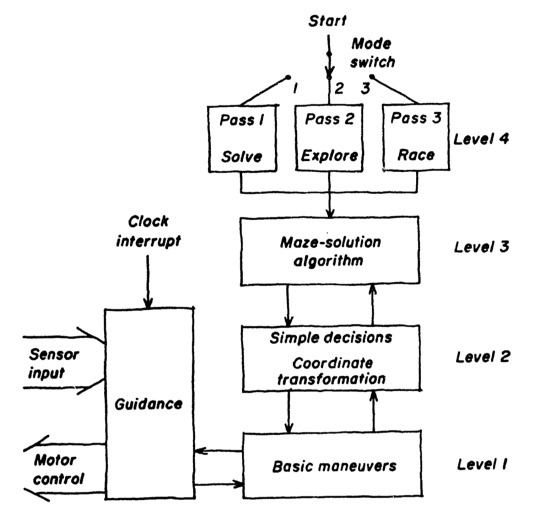
Moonlight Special MS-I (1978) by Art Boland, Ron Dilbeck, Philip Stover, Roy Kelly, Timothy Harrington, and James Thomas, Battelle Northwest Laboratories, WA. IEEE Spectrum launched the Amazing Micro-Mouse Maze Contest in May 1977, competitors were challenged to design and construct a self-contained "thinking mouse" that could solve a 10′ by 10′ maze. MS-I has four levels of intelligence as shown in the second image above. Level 1 provides basic movement, interfacing with the mouse's two motors and sensors to turn left, turn right, go straight, or turn around. Also included at level 1 is the guidance control necessary to prevent contact with the maze walls. Level 2 interprets lower level sensor readings, keeping track of the mouse's current position in the maze, and controlling motion where there is no choice such as corners. Level 3 processes maze junctions with multiple choices, handling new junctions by choosing a direction at random. In MS-I, level 4 provides the mouse the ability to learn from one pass to the next.
"At the first time trial, MS-I was found to be sensitive to the strong incandescent booth lights and those of the local CBS television videotaping crew, which emit heavily in the infrared region and blinded its optical sensors. The sensors have now been AC coupled and modulated to provide better immunity to such light." – Three amazing micromice: hitherto undisclosed details, by Roger Allan, IEEE spectrum November 1978.
33 notes
·
View notes
Text

INTERROGATION LOG // IL-01-003
Protocol ID: IL-01-003
Module: Module 01 – Foundational Breach
Entry No.: 003
Category: Emotional Containment
Title: Emotional Enforcement
Subline: Neutralizing facial cues of resistance.
Issued by: S.C.D.D.
⸻
ENGAGEMENT CONDITIONS
Initiate this protocol when the subject begins to exhibit subtle, involuntary defiance during silence or command observation. Observable resistance indicators include: tensed jawline, narrowed eyes, twitching lips, shallow breathing, or a faint smile of insolence. These cues precede verbal challenge and must be neutralized immediately to prevent escalation.
⸻
ENFORCEMENT DIRECTIVE
1. Interrupt eye contact without warning. Lower your gaze directly to the subject’s mouth.
2. Allow three seconds of silence. Let them feel dissected—objectified—evaluated.
3. Speak only this: “Wipe that from your face.”
4. Hold a five-second stare at the affected area. Provide no interpretation. Let them scramble.
5. Repeat the command only once, quieter: “Now.”
6. Step back half a pace. Fold your hands behind your back. Do not react to their confusion.
7. Conclude with a calibrated statement: “You’re not here to express. You’re here to obey.”
⸻
DOCTRINE PRINCIPLES
• Facial control precedes behavioral compliance.
• The face is the final mask of defiance; once broken, the interior follows.
• Resistance thrives in ambiguity—eliminate it through visual disruption.
• Reactions must be unprocessed, disarmed before they solidify into words.
⸻
INSTRUCTIONAL NOTES FOR ALPHA CANDIDATES
This is a surgical strike—not a confrontation. Your silence is the scalpel; your gaze is the incision. Do not mistake subtle expressions for minor threats. In deviant psychology, micro-resistance is the root of relapse. Cut it before it blooms. Authority is visual first, vocal second.
⸻
REMINDER TO ALL COMMAND-CLASS OPERATORS
Neutralize expression. Then command obedience.

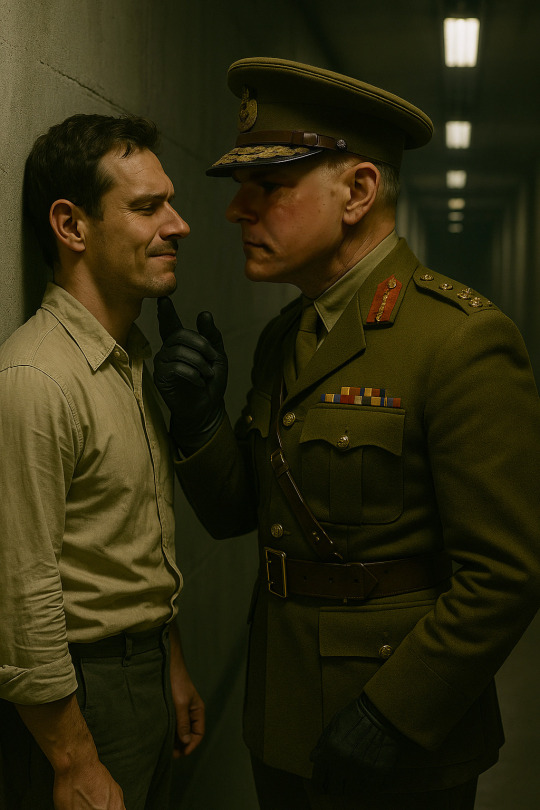

#InterrogationLog#AlphaMastery#EmotionalContainment#FoundationalBreach#SubjugationProtocol#MentalSuppression#CommandDiscipline#NoEmotionNoNoise#scdd#power#authority#command#discipline#leadership#mastery#alpha confidence#alpha mindset#alpha master#absolute discipline
17 notes
·
View notes
Text
In the Bayverse feral human carrier au, I really love the idea that Optimus carries you around on his shoulder.
Cybertronians are able to shift their frames on a micro-scale level, so he's able to produce a contained area with enough holds and comfortable for you to rest. Plus, with your newfound enhanced body, your grip strength has been greatly enhanced and you unconsciously manipulate your own electromagnetic fields to produce a magnetic effort to stick in place.
(Optimus thinks that you know that you're doing that, so he gets later confused when you complain about losing car keys to a rental car, so that's another conversation that happens.)
It keeps you and everyone else out of trouble because of the effects of bridging the human lizard brain and Cybertronian feral-protocols. You're basically a living detector for Cybertronians, while the nearby mechs can't help but be keenly aware of your pinging distressed presence. This keeps your hyperactive fight-or-flight reaction under control, and gets the other mechs to back off since Optimus essentially wrangles and modulates your and newspark's fields -it calms the instinct to flee the vicinity or make a mean attempt to swim away from the Diego Garcia base.
(On a side note, Sam tried to perch on Bumblebee as well, but nearly pancakes himself because he doesn't have magnetic abilities. Mikaela has it recorded.)
#transformers#transformers bayverse#bayverse#reader insert#optimus prime#optimus#pregnancy#feral human carrier au#bitlets#sparklings#cybertronian biology#tf headcanons#my writing#my thoughts#maccadam#bumblebee#mikaela banes#sam witwicky
272 notes
·
View notes
Text

Distortion, distortion, distortion.
Went into this patch without any clear direction - most importantly, I knew I wanted to pan around some drums a bit, since I picked up Jumble Henge which I've wanted to get a bit more space on the kit forever.
Marbles acts as the master clock, with T2 clocking Zularic Repetitor and Data Bender. ZR on pattern 01000 controls Daiko for metallic percussion through IDUM, and ABD Kicks without trigger modulation. Taiko is triggered directly from T3, acting mostly as a snare.
T1 clocks Bloom (acting as a clock multiplier and sequencer) and triggers Sinc Bucina, which is where we get to the lead? Distorted bass? I really have no clue what to call it - it's a sound I cam across just patching and re-patching. Telharmonic receives Tonic CV from Bloom and Degree CV from X1. Phase output plays through Sinc Bucina, getting heavily filtered, then Strega. Strega applied heavy distorting saturation, very light reverb, and hi-pass filtering. The voice finally goes into Data Bender with additional saturation, in micro mode, with low repeats. All of these processing stages together create that noisy sound, as well as the novel rhythm. There's just something about it.
Some additional pings come from Ts-L, bitcrushed by o_C and through Ikarie and panned around with an LFO.
Ultimately a very cool patch, and one that's pretty much impossible to recreate. Very happy to have Marbles back in the rack right now, it is an inspiration machine.
#modular synth#erurorack#breakcore#breakbeats#idm#glitch music#experimental music#gif#flashing gif#glitch art#noise#noise music#industrial#industrial music#music#electronic music
91 notes
·
View notes
Text
Sleeping Pods for Conscripts
Sleeping Pods for Conscripts
The Sleeping Pods for Conscripts are advanced, integrated rest modules designed for use by military personnel in the Republic's paramilitary forces. These pods are engineered to accommodate conscripts sleeping in their full-body armor, including helmets, providing a seamless, secure, and efficient method of rest and recuperation.
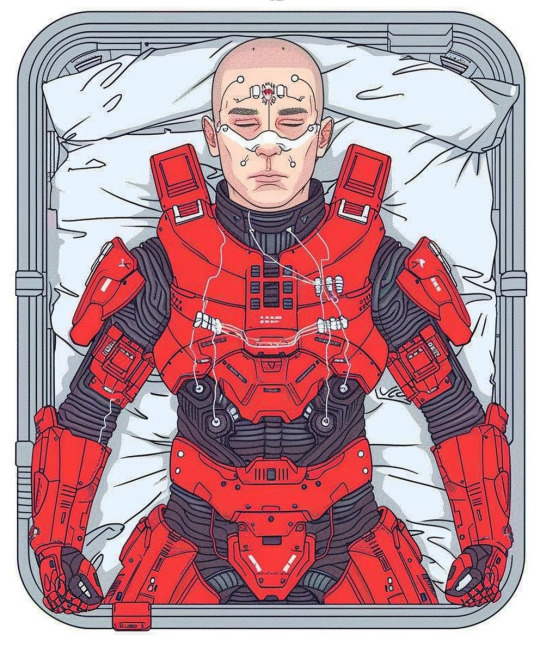
Overview
The sleeping pods represent the pinnacle of military sleep technology, blending comfort with utility to ensure that conscripts remain battle-ready even while at rest. Each pod is constructed from a durable, high-grade composite material that offers protection and insulation, effectively creating a self-contained micro-environment.
Functions and Features
Waste Evacuation System Each pod is equipped with an integrated waste management system that connects directly to the conscripts' armor suits. This system efficiently handles all biological waste, ensuring hygiene and comfort without the need for the conscript to leave the pod.
Power Charging Interface The pods feature a sophisticated power interface that connects to the conscripts' armor suits, ensuring that all electronic systems, including communication devices, HUDs (heads-up displays), and life support systems, are fully charged and operational upon waking.
Life Support Integration The pods are equipped with advanced life support systems that monitor and regulate the conscripts' vital signs, providing real-time data to the central command system. This includes oxygen supply management, temperature control, and emergency medical response capabilities.
Hydration System To maintain optimal hydration levels, the pods are fitted with a hydration system that supplies water directly to the conscripts' armor suits. This system ensures that conscripts remain hydrated throughout their rest period without needing to remove their helmets.
Sensory Deprivation and Noise Cancellation To ensure optimal rest, the pods utilize state-of-the-art sensory deprivation technology, including noise-canceling mechanisms and adjustable ambient lighting. This creates a tranquil environment, free from external disturbances.
Communications Link Each pod maintains a secure communication link with central command, allowing for instant alert and mobilization if necessary. This link also enables conscripts to receive updates and briefings without leaving their pods.
Ergonomic Design Despite the full armor requirement, the pods are ergonomically designed to offer maximum comfort. Adjustable internal padding and support structures conform to the contours of the armor, reducing pressure points and ensuring a restful sleep.
Quick Egress System In the event of an emergency, the pods are equipped with a rapid egress system that allows conscripts to exit and mobilize within seconds. This system is synchronized with the conscripts' armor to ensure immediate readiness.
Environmental Conditioning The pods maintain a controlled internal climate, adjusting temperature and humidity to optimal levels for rest. This conditioning also includes air filtration systems to remove contaminants and ensure a clean breathing environment.
Hot Bunking Capability Designed for efficiency, the pods support hot bunking, allowing multiple conscripts to use the same pod in shifts. The pod’s systems quickly sanitize and reset between uses, ensuring each conscript has a clean and ready environment.

Operational Benefits
The integration of sleeping pods into the conscripts' daily routine offers several operational advantages:
Enhanced Readiness: Conscripts remain in their armor and can be deployed instantly, reducing response times during critical situations.
Improved Health Monitoring: Continuous vital sign monitoring ensures early detection of health issues, allowing for prompt medical intervention.
Increased Efficiency: By managing waste, hydration, and charging needs within the pod, conscripts can maximize their rest periods, leading to improved performance during active duty.
Resource Optimization: Hot bunking capability allows for efficient use of space and resources, accommodating more conscripts with fewer pods.
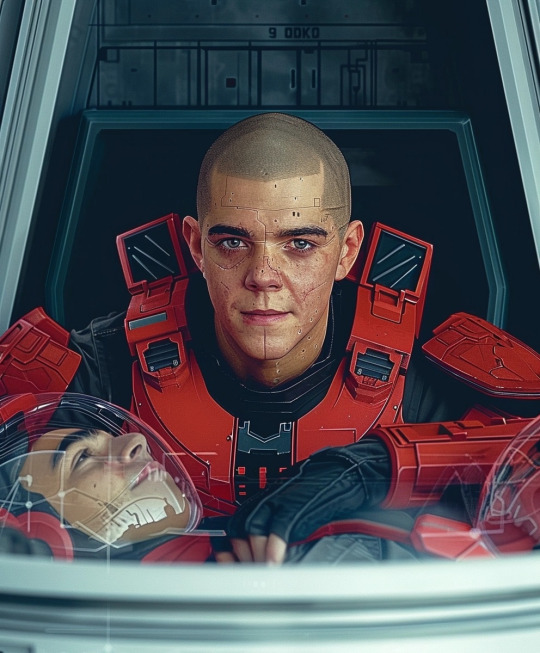
Usage
The sleeping pods are deployed in all major barracks and outposts within the Republic's territory. They are a standard feature in the accommodation of Enforcer Cadets, Paramedic Corps members, Lifeguards, and other paramilitary units. Each pod is assigned to an individual conscript and is programmed to recognize and interface exclusively with their specific armor suit.
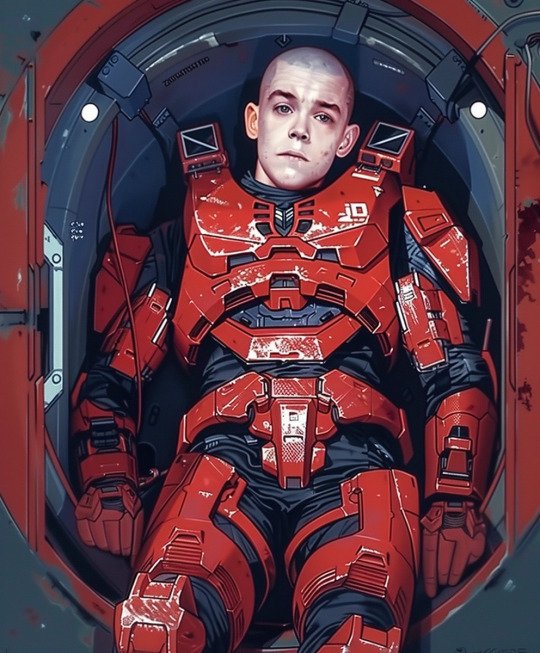
See Also
Armor Suits of the Republic
Neuro-Based VR Training Modules
Life Support Systems

References
Republic Defense Technologies Manual, 2047 Edition
Advanced Military Rest Systems: Enhancing Soldier Efficiency and Readiness by Dr. V. Harkness
The Integration of Technology in Modern Warfare by Prof. K. Linwood
This article is part of the Republic's Military Technology Series, providing detailed information on the advanced systems used to maintain the security and efficiency of our paramilitary forces. For more articles, visit the Republic Military Archive.
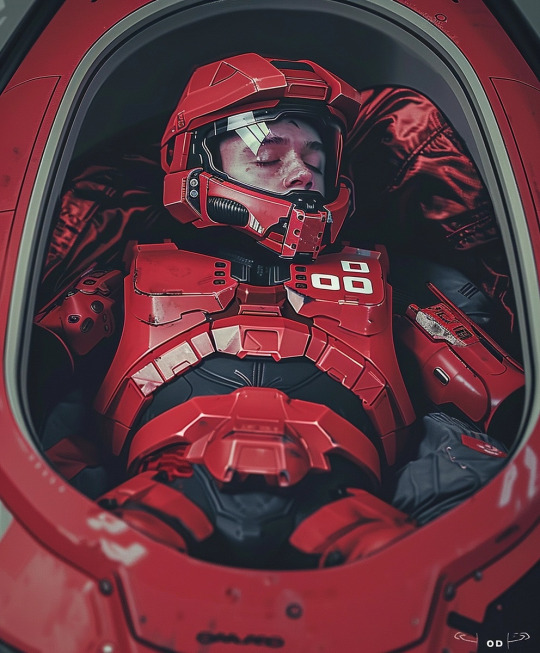
5 notes
·
View notes
Text





𝑻𝒉𝒆 𝑪𝒍𝒆𝒎𝒆𝒏𝒕𝒊𝒏𝒆 𝒑𝒕. 𝟐: 𝒅𝒆𝒔𝒊𝒈𝒏 𝒂𝒏𝒅 𝒔𝒚𝒔𝒕𝒆𝒎𝒔
𝒔𝒄𝒊-𝒇𝒊 𝒅𝒓

𝒔𝒉𝒊𝒑 𝒄𝒍𝒂𝒔𝒔 𝒂𝒏𝒅 𝒄𝒐𝒏𝒇𝒊𝒈𝒖𝒓𝒂𝒕𝒊𝒐𝒏
Class: Modified mid-class freighter (original designation untraceable)
Dimensions: Compact and fast—built more for speed and evasion than cargo bulk
Original Use: Unknown. Judging by the design mix, she may have once been a light cargo hauler, but at this point, almost nothing about her is stock.

𝒉𝒖𝒍𝒍 𝒂𝒏𝒅 𝒂𝒓𝒎𝒐𝒓
Plating: Mismatched but reinforced. Some hull panels are standard titanium composite, others are salvaged from military vessels. I once found a piece stamped with a defense contractor logo. Soren played dumb.
Damage Markers: Scars from asteroid grazes, plasma burns, and at least one railgun strike that tore through the starboard side before being patched with a piece of what appears to be an old satellite dish.
Stealth Coating: A stolen stealth coating on one side (only one side), giving her a bizarre half-gloss appearance when flying in certain light.

𝒑𝒓𝒐𝒑𝒖𝒍𝒔𝒊𝒐𝒏 𝒂𝒏𝒅 𝒎𝒂𝒏𝒆𝒖𝒗𝒆𝒓𝒂𝒃𝒊𝒍𝒊𝒕𝒚
Here’s where things get... illegal.
Engine Type: Tri-core fusion drive (overclocked illegally)
Thrusters: Multi-angle vectoring thrusters scavenged from a racing skiff
Hyperspace Drive: Installed after-market. Very not standard. Definitely not licensed. Burns through fuel like sin, but gets the job done.
Maneuverability: Shockingly agile for her size. She’s not built to win dogfights—she’s built to not get hit.
Speed: Capable of outpacing most patrol cruisers and nearly anything in her class. Soren once escaped a blockade by flipping her vertical, killing main thrust, and gliding between two gunships with only manual microthrusters. Clemmy didn’t love that. But she did it.
Max Velocity: Classified (by Soren) as “if she shakes apart, you pushed her too far.”
Signature Trick: Emergency micro-bursts for fast stops or rapid angular shifts—great for dodging, terrible for unsecured passengers.

𝒐𝒇𝒇𝒆𝒏𝒔𝒊𝒗𝒆 𝒔𝒚𝒔𝒕𝒆𝒎𝒔
While not technically a warship, Clemmy has teeth—and Soren is not shy about using them.
Primary Weapons:
Retractable twin plasma cannons mounted under the nose (illegally modified for rapid cycling)
Hidden turret along the dorsal fin with full 360° tracking (camouflaged beneath sensor shielding)
Secondary Systems:
Ion net disruptor (used for disabling ships mid-chase)
Forward grappling harpoon (officially for salvage… unofficially for “creative boarding solutions”)
Mod Notes: All weapons have been internally rewired for faster charge times and energy efficiency. Soren insists it’s “completely safe.” The ship disagrees. The floor near the control relay is still scorched.

𝒅𝒆𝒇𝒆𝒏𝒔𝒊𝒗𝒆 𝒔𝒚𝒔𝒕𝒆𝒎𝒔
Shielding: Layered energy-dispersal field adapted from outdated military specs. It’s finicky, but when tuned right, it can absorb an entire volley without so much as a flicker.
Hull Reinforcement: Polyceramic inner shell under the patchwork hull. Not factory standard. Probably military surplus. Possibly stolen.
Cloaking:
Partial stealth mode: One side only. Meant for short bursts, ambushes, or dodging sensor sweeps. Jax once described it as “trying to hide behind your own arm.”
Signature Dampeners: Basic-grade dampeners, good enough to fool low-level scans or confuse weapons locks for a few seconds.
Countermeasures:
Chaff and flare deployment for missile evasion
ECM scrambler array that definitely violates at least five galactic communication laws
Reinforcement Field: Short-range gravitic pulse projector, used to knock boarding parties off balance or repel magnetic tethers.

𝒏𝒂𝒗𝒊𝒈𝒂𝒕𝒊𝒐𝒏 𝒂𝒏𝒅 𝒑𝒊𝒍𝒐��𝒊𝒏𝒈
Primary Navigation System: Jury-rigged hybrid between an outdated freighter nav-core and a racing AI module. The interface is messy, but the calculations are blindingly fast—when they don’t crash mid-jump.
Manual Controls: Everything important is mapped to tactile controls. Soren doesn’t trust full automation. If the nav AI glitches mid-dive, he wants to feel the override.
Autopilot: Exists. Technically. Mostly used as a glorified parking brake or when Soren needs to sleep for 20 minutes in a safe orbit.
Charting Software: Half-legal, half-pirated. Capable of plotting hyperspace routes through narrow, high-risk corridors that most ships avoid.
Backup Systems: A wall-mounted hardcopy star chart in the cockpit. Just in case. Zia thinks this is hilarious. Soren calls it “responsible.”

𝒅𝒐𝒄𝒌𝒊𝒏𝒈 𝒄𝒂𝒑𝒂𝒄𝒊𝒕𝒚 𝒂𝒏𝒅 𝒂𝒄𝒄𝒆𝒔𝒔
Docking Clamps: Can attach to standard civilian ports, refueling stations, and most illicit trade hubs. May need to be “persuaded” into alignment.
Shuttle Bay: None. She’s too compact for internal hangars. Instead, she has one reinforced top-hatch cradle rigged for small detachable pods—used rarely, and only when absolutely necessary.
Airlocks:
Main Port: Standard-sized, sealed, and usually a bit stubborn when opening.
Secondary Hatch: Hidden behind a supply wall in the engine bay. Used for stealth entries and exits.

𝒓𝒆𝒑𝒂𝒊𝒓 𝒂𝒏𝒅 𝒎𝒂𝒊𝒏𝒕𝒆𝒏𝒂𝒏𝒄𝒆 𝒏𝒆𝒆𝒅𝒔
Routine Repairs: Constant. Something is always groaning, leaking, sparking, or “just about to give out but not yet.”
Spare Parts: Stored in crates scattered across the ship—engine parts in the pantry, coolant lines under the bench seat, wiring spools in my hydroponics pod (which I do not appreciate).
Self-Diagnostics: Unreliable. The system either reports “everything is fine” (it’s not), or starts shrieking about seven simultaneous reactor leaks (there are none). Soren usually ignores it and just listens to the hum of the engine to diagnose problems.
Repairs in Flight: Doable. Often necessary. Soren has made mid-warp hull welds while dangling from a tether. Zia once had to climb into the bulkhead to manually restart a fried fuse bank after a flare surge.
Critical Weakness: The fuel converter. If anything’s going to go first, it’s that. It’s been patched, rewired, and coaxed with offerings—but one day, it’s going to die loudly.

𝒔𝒚𝒔𝒕𝒆𝒎 𝒊𝒏𝒕𝒆𝒈𝒓𝒂𝒕𝒊𝒐𝒏
Power Grid: Custom-wired. Inconsistent. If too many systems are running at once (say, stealth mode, shields, and weapons), things start flickering. Choosing what gets power is sometimes a strategic decision—or a desperate one.
AI Integration: No full AI. Just a scattered handful of voice-assist systems, diagnostic subroutines, and a navigation core that occasionally asks Soren if he’s “sure about that” when he plots something stupid.
Voice Recognition: Primarily responds to Soren’s voice, but Zia has jury-rigged access to certain commands—especially life support, lighting, and doors.

𝒅𝒐𝒄𝒌𝒊𝒏𝒈/𝒃𝒐𝒂𝒓𝒅𝒊𝒏𝒈 𝒇𝒆𝒂𝒕𝒖𝒓𝒆𝒔
Hard-dock only. No fancy mag-coupling or remote landers.
Zero-G Transfer Capability: Yes, with magnetic grip points and a manually sealed transition tunnel.
Boarding Defense: Reinforcement field, sealed bulkheads, and at least three blasters stashed near the doors “just in case.”

𝒔𝒚𝒔𝒕𝒆𝒎 𝒏𝒐𝒕𝒆𝒔
Most systems are custom-built, hotwired, or frankensteined together. Only Soren knows how everything works—and even he sometimes has to hit things to make them run.
Diagnostics require manual calibration. The ship’s internal sensors are either hyper-sensitive or utterly dead.
Flight path records? Wiped. Regularly. On principle.
𝒊𝒏 𝒔𝒉𝒐𝒓𝒕:
Clementine might look like a rustbucket. But she’s got the firepower of a private gunship, the speed of a racer, and the evasive instincts of a hunted animal. She doesn’t win fights with brute force—she wins them by being faster, smarter, and just illegal enough to stay one step ahead of the galaxy’s worst.

𝒆𝒙𝒕𝒓𝒂
Ok, I'm gonna be honest here, my friend who's really into sci-fi had to help me write most of this, because as I've said before, I know like nothing about it. So all the fancy technical stuff in here was all him.

@aprilshiftz @lalalian
#reality shifting#shiftblr#desired reality#shifters#scripting#original dr rambles#reality shifter#dr scrapbook#original dr scrapbook
6 notes
·
View notes
Text
Expanding the 6Q-System

Hey TTRPG family,
Since a lot of you seem to like my free game 6Q, I've been kicking around some ideas for setting modules for it, and I'd love to get your input. I'm currently considering eight different settings, each with its own unique flavor. Take a look at these summaries and let me know which ones grab you the most:
🌆 Cyberpunk Megacity: Navigate a neon-drenched domed metropolis where climate control has gone haywire and micro weather haunts the districts. Help claw back control of the very weather from the corrupt corps exploiting it.
🐉 Mythic Fantasy Realm: Explore a world where forgotten gods walk among mortals and ancient magic pulses through the land. Your choices will shape the destiny of a realm teetering between rebirth and oblivion. May the fog spare you.
🪐 Space Opera Fringe: Carve out your legacy on the edge of known space, where alien mysteries and human ambition collide. The key to uniting worlds may lie in the unlikliest of friendships.
🕴️ Supernatural Investigation Agency: Join a clandestine organization tasked with keeping the supernatural hidden from the public eye. Balance maintaining the veil under which society operates with uncovering otherworldly truths that threaten reality itself.
🏜️ Post Apocalyptic Reconstruction: In a world ravaged by catastrophe, lead the charge to rebuild civilization. Your choices will determine not just survival, but the very nature of the society that rises from the ashes.
🎩 Steampunk Conspiracy: Unravel a web of secrets in a world of brass and steam, where science and the occult intertwine. Your inventions and deductions could topple empires or usher in a new age of enlightenment.
☀️ Solarpunk Utopia: Shape the future in a world that has overcome its greatest challenges through technology and social change. Explore the complexities of maintaining harmony while striving for perfection.
🏡 Slice of Life Community: Build connections and navigate personal growth in a close-knit community. Discover the extraordinary in the ordinary as you help shape the lives of those around you.
I'm genuinely curious to hear which of these resonates with you. Your input will be a big help as I expand 6Q. I can't promise I will nail every setting as some of these are challenging for me and outside my expertise. And of course details may change. I hope to get to every setting in due time, but your choice tells me what I will work on first. Cheers!
Feel free to share your thoughts in the comments - I'm always interested in hearing your ideas and what you'd like to see.
Thanks for being part of this journey with me. Please repost if this interests you, I would love to get as much input as possible! Looking forward to seeing what you all think.
#ttrpg#indie ttrpg#ttrpg community#indie ttrpg design#freettrpg#ttrpg design#table top role playing game#tabletop rpg
8 notes
·
View notes
Text
Gifts for the aviator nerds or airplane geek in your life!
Smartphone-Controlled Paper Airplane Kit
Buy here!
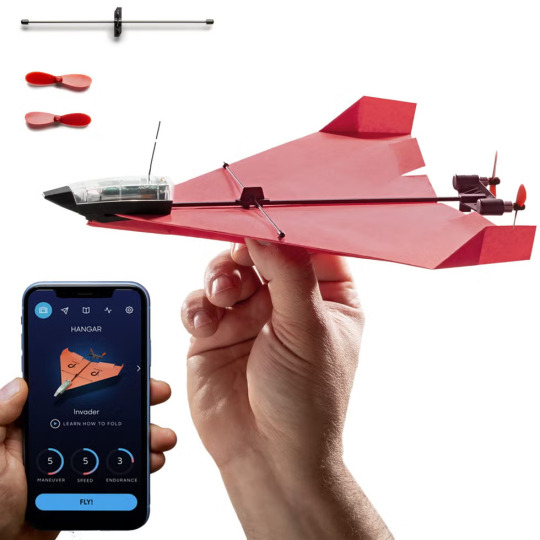
POWERUP 4.0 Smartphone Controlled Paper Airplane Kit, RC Controlled. Easy to Fly with Autopilot & Gyro Stabilizer. For Kids and Adults. DIY STEM Tool
PILOTED FLIGHT - Grab a sheet of paper, fold it, and go! Instantly put yourself in the cockpit of an amazing smartphone controlled paper airplane that does high speed tricks. The bluetooth module, which includes autopilot control, connects to your phone so you can experience the sensation of flying countless paper, foam, and even Balsa Wood airplane models.
INCREDIBLE STABILITY - Loops, Barrel Rolls, & Hammerheads are achieved with the special Acro Mode! Your paper plane?s onboard computer automatically calibrates your paper airplane for imperfect weather with a built-in launch assist and wind stabilizer. Now hobbyists, tinkerers, or students can become the flight controller!
RAPID CHARGING - A 30 minute quick charge gives you 10 minutes of flight time along with an incredible range of up to 230ft! Traveling up to 20mph, your plane will spend less time on the tarmac and more time in the air. Simply connect the included micro USB cable to a charging port and plot out your next journey.
STEM READY - Experience the aerodynamic forces that make flight possible through various wing configurations. Lift, drag, thrust, and gravity are learned first hand. Purchase the Night-Flight Kit and Accessory Kit to see how different parts create a new experience. Great for an outdoor class or exploration together with family.
DURABLE - A near indestructible heavy duty carbon fiber body includes a nylon reinforced nose and motor mount. The POWERUP 4.0 paper airplane set is designed to withstand bumps, bangs, and even an unexpected crash. If your paper plane flies out of range, the onboard computer will safely land itself! Includes a one year warranty.
Buy here!
#aviation#aircraft#plane#flying#airplanes#paper planes#origami#nerdy gifts#handmade gifts#gifts#unique gifts#gift ideas
2 notes
·
View notes
Note
Cuz that’s the thing with Viktor, there’s not much that’s beyond his control these days, and that’s by design (...) you can’t do that forever. It’ll eat you alive.
Jayce learns the hard way when Viktor is about to implode. His movements become more stiff, with random bursts of gear grinding and jolts. The shimmer injectors working iust little more than usua. He goes almost mute, but when he talks the modulator sound even raspier. He doesn't take off the mask.
I was just gunna answer this with some more meta or analysis but you know what… this one deserves a little ficlet. Let’s call it Overheated.
Overheated
Jayce knew something was wrong the moment he stepped foot inside Viktor’s lab. Sure, the air was stifling from the myriad of running machines and clouds of puffy steam… but it was the subtle little in-between things that tipped Jayce off; like a single snagged thread pulling at a compromised seam. It was the why that mattered.
It was stifling and hot because something was throwing off Viktor’s usual protocols. Something was clouding his typically routine-oriented mind, keeping him from noticing the abnormally warm and hazy state of his lab. He was fixated on something, fixated hard enough that the best interest of his gadgets was slipping his mind.
Jayce could hear him before he could see him—loudly tinkering away around the corner in what stood for a measly bedroom. And there was a shortness, a tension to said tinkering that didn’t usually plague Viktor’s work. Usually, he was precise and careful to a fault; his work so clean, well… a machine might as well have done it.
And while Viktor’s moods were wholly different nowadays, given the emotional suppressor, Jayce was beginning to re-learn them. He’d once likened it to putting a diamond under a hydraulic press—it would be tough, it would be fortified. It could withstand more pressure than almost any other substance on the planet. But eventually something would give. And it wouldn’t go quietly, either; no, it would be explosive.
So rather than injecting himself into that maelstrom, Jayce steered clear of his former partner for now and instead went about doing what he knew he could to help—wandering quietly into the workshop proper and flipping the switch to power on Viktor’s air filtration system. If they’d been in Piltover, he could have just popped a few windows open, but down here in Zaun, that would just pollute the air further.
So next he went for the cooling fans over in the corner where Blitzcrank’s charging bay sat empty, and angled them toward Viktor’s bedroom before flipping those on as well. And finally, after listening for a moment and hearing only a loud crash and litany of mumbled bilingual curses, Jayce went for the small kitchen counter, rinsed the sole mug that didn’t have cracks in it, and poured a healthy amount of sweetmilk.
Then it was just a matter of wrangling this particular runaway train. So Jayce steeled himself, clutching the mug close to his chest as he meandered into Viktor’s bedroom.
It was immediately clear where the steam had come from—not the many running machines, though those were noticeably hot even from several feet away—no, it was Viktor himself.
The vents in his neck were set at an extreme angle, letting out puff after puff of heavy, thick steam that occasionally turned black when Viktor released a particularly strained breath. There was loud, chaotic rattling resonating from points of tension all over his mechanical body—his neck, his chest, his left arm and leg. And beneath it all, the subtle little hiss of the Shimmer injectors as they delivered micro doses like clockwork to combat his visibly agitated state.
That was the thing about suppressing his emotions… suppress them long enough, and they’re bound to recoil. It was simple physics—and while Jayce could have mentioned this, could have piped up about I warned you this would happen, that this isn’t healthy, and now look what it’s done to you, that would just be throwing gasoline onto the fire, and that was the last thing Viktor needed. So Jayce went a different route.
He cautiously stepped forward, patting Viktor on the back once to announce his presence before leaning past him and setting the mug down in the only mess-less corner he could find.
“You, uh… you wanna talk about it?” he asked, cringing at the mother-hen inflection.
Viktor did not answer—instead taking a single step to the side and deliberately turning his back on Jayce. The vents in his neck sent out another huff of black, and Jayce took this for what it was; don’t mother me, it’s insulting.
But Jayce wasn’t deterred—after all, why was a little mothering such a bad thing? Some care, some consideration, some warmth and doting? Everyone could use that every once in a while. Yes, even the infallible Machine Herald. Especially the infallible Machine Herald.
“V?” he prodded, his hand hovering at Viktor’s back as he tried to decide if touching was the best idea right now.
“No,” Viktor snapped, and even just from that one word alone, Jayce could hear the stress on the voice modulator—low and raspy, as if he’d recently spent a significant amount of time raising his voice.
“Okay,” Jayce agreed, retracting his hand and taking a step away—just freeing up Viktor’s space so he wouldn’t feel so constricted.
Instead, Jayce peered down at the project Viktor had been angrily funneling his not-very-suppressed emotions into. It appeared to be a modification for Blitzcrank’s revolving gadget arm; replacing several busted or outmoded gadgets and rewiring the entire thing to make switching between options a quicker and more seamless operation.
So without another word, Jayce pulled up a stool, grabbed Viktor’s spare pliers, and went to work—removing and rewiring the attachment ports, thus freeing Viktor up to focus on the gadgets themselves.
And for the longest time, they simply worked—shoulders bumping every so often as they just shared in the silence, in the heady weight of each other’s company. They worked, as they always had, like a well-oiled machine; wordlessly passing tools to each other and reading the other’s needs as if it were their own. And slowly but surely, the rattling within Viktor’s chest began to go quiet, the hissing tempo of his overworking injectors steadily slowed and eventually stopped. And Jayce could hear it more than see it when the tension in those rigid metal shoulders relaxed—a creak and a groan like hot metal plunged into an ice bath.
Finally, after Gods knew how long, Viktor’s movements ceased entirely—his hands stalling where they were turning a bolt on the wrist rotator and a single, long sigh leaving the voice modulator like struck glass.
Jayce mimicked it, stilling his hands and turning his head to peer at the flat, unreadable surface of Viktor’s mask with eyes that hopefully said are you okay now? That’s all I wanted, all that mattered—that you’re okay.
And he wasn’t sure how, but he could just tell Viktor was giving him a withering, grateful grin under that mask.
“Thank you, sluníčko,” he said, voice even and harmonic like morning church bells.
Jayce offered up a proud, toothy smile before leaning in and placing a quick, chaste kiss to the mask, right where Viktor’s lips would be—silently communicating that I know you feel like you have to keep it on sometimes, that you don’t like what you’re feeling, and you don’t want anyone to see that, even me. And that’s ok. Keep it on, if that’s what makes you comfortable. I can love you with it on just the same.
A new series of whirs and clicks went off in Viktor’s neck, followed by a short burst of steam, but this time Jayce knew them to be a good sign—the Machine Herald’s version of a blush.
31 notes
·
View notes
Text
The Future of Low Voltage Switchgear: What’s Next?
Low voltage switchgear plays a critical role in power distribution, ensuring safe and efficient operation across industries such as manufacturing, commercial buildings, healthcare, and renewable energy. With rapid technological advancements, the future of low voltage switchgear is evolving to meet the demands of digitalization, energy efficiency, and sustainability.

Digitalization and Smart Switchgear:
Digital technology is in fact one of the greatest revolutions of low voltage switchgear. Smart switchgear has the capability of IoT (Internet of Things) for real-time monitoring, predictive maintenance, and remote control.
Smart Low Voltage Switchgear: Market Trends and Analysis:
Real-time Data Monitoring: Sensors that conduct data collection and analysis of the voltage, current, temperature, and health of devices.
Predictive Maintenance: With a year of analysing AI-powered data, predicting failures before they happen to reduce downtime and in turn maintenance costs.
Cloud Connectivity: Operators have access to switchgear data from any location, improving remote monitoring and control.
Data Processing Power: AI integration in automation systems speeds up data processing, allowing for faster decisions.
Energy Efficiency and Sustainability:
With rising awareness around sustainability across the globe, manufacturers of low voltage switchgear are designing energy efficient solutions to minimize carbon footprints.
Sustainable Innovations in Low Voltage Switchgear:
Eco-Friendly Insulation Materials: Manufacturers are substituting SF6 (a powerful greenhouse gas) with eco-friendly options.
Low Power Consumption Designs: Designs lose energy less, leading to superior efficiency.
Integration of Renewable Energy: Switchgear is being optimized to manage both solar and wind power, ensuring that the grid runs smoothly.
Recyclable Components: Many more switchgear systems utilize recyclable materials when they reach the end of their lifecycle.
Safer and More Reliable:
Safety remains a top priority in electrical distribution systems. Future low voltage switchgear will incorporate advanced protection mechanisms to minimize electrical hazards and enhance reliability.
Upcoming Safety Enhancements:
Arc Fault Detection Systems (AFDS): These systems detect and suppress like arcs before they harm.
Self-Healing Systems: AI-based switchgear can automatically redirect electricity in the event of failures, avoiding outages.
Touch-Proof Designs: Designs that are insulated and enclosed to avoid accidental electric shock.
Remote Operation and Diagnostics: This minimizes the extent of physical manual inspections resulting in operator safety.
Modular and Compact Designs: Switchgear is getting increasingly modular and compact, as industries call for more flexible and space-saving solutions.
Features of Modular Low Voltage Switchgear:
Scalability: Switchgear can be modified or scaled up or down to meet businesses’ needs, while maintaining system efficiency.
Reduced Installation Time: Pre-configured modules simplify the process of installation, resulting in less labor costs.
The positioned components for simple replacements and upgrades.
The Rise of Solid-State Switchgear:
Industrial low voltage switchgear are mostly mechanical-latch based circuit breakers but the future lies in solid-state low voltage switchgear using semiconductor based switching technology.
Advantages of Solid-State Switchgear:
Speedy Switching: Solid-state systems work on micro seconds, making fault response time low.
Zero Mechanical Wear & Tear − Moving parts are absent, so switchgear has a longer life and better reliability.
Silent Operation: No sound that comes with a conventional electromechanical breaker
Low Maintenance: It is cost-effective owing to lower failures and servicing.
Integration with Smart Grids:
It plays a vital role in the function of smart grid infrastructure as it helps in the distribution of energy and load balancing in a seamless manner.
The Impact of Smart Grids on Low Voltage Switchgear:
Real-time Load Management: Switchgear will do real-time Load Management based on the requirement.
Self-Healing Networks:��When a fault occurs, the system will redirect electricity to unaffected areas.
Cybersecurity: With the growing digitalization, manufacturers will adopt robust cybersecurity measures to prevent cyber threats.
AI and Machine Learning in the Healthcare Sector:
With the world’s transition to advanced technology, AI-powered switchgear will be the new ‘normal’ providing more automation and intelligence to power distribution.
Use of AI in Low Voltage Switchgear:
Anomaly detection: AI can find abnormal power consumption and recommend remedial measures.
Energy Forecasting — Machine learning algorithms will be used to forecast energy consumption trends, helping businesses optimize their energy consumption.
Adaptive Systems: AI will maintain optimum settings that increase performance and lifespan.
Conclusion
The future of low voltage switchgear is digital, efficient and green. Thanks to IoT, AI, solid-state technology and smart grids, these advancements will transform power distribution into a safer, smarter and more reliable system.
Adoption of Next Gen switchgear is crucial for modern enterprise to act proactively for cost efficiency and sustainability in energy usage with next gen technologies to leave the competition behind in the market.
6 notes
·
View notes
Text

Transaction Security and Management of Blockchain-Based Smart Contracts in E-Banking-Employing Micro-segmentation and Yellow Saddle Goatfish
Authored by:- Wid Alaa Jebbar and Mishall AL-Zubaidie
for full-length paper press here.
Abstract:-
Our research attempts to improve the system in which banks deal with the security of financial transactions. This research leverages the idea of micro-segmenting the entire system into designated zones to concentrate on security, where each zone has its own rules and limitations. These rules are managed by a smart contract, which decides whether they have been observed to verify the legitimacy of the customer. First, the two-phase commit algorithm (2PC) was used to specify the type of e-banking request. After this, the micro-segmentation principle was applied to isolate each type of e-transaction process alone in a separate segment. Then, the yellow saddle goatfish algorithm (YSGA) was used to determine whether the smart contract conditions were optimized. Finally, if the customer is authorized, then the entire transaction process is saved in the blockchain's main ledger and secured by a unique hash. The blockchain application makes our system capable of dealing with large numbers of users in a decentralized manner.
Facts:-
Our system has been examined against several recent well-known assaults/attacks, such as falsification, advanced persistent threat, bribery, spoofing, double spending, chosen text, race, and transaction replay attacks, and has proven to overcome them. In terms of the performance evaluation, we obtained an execution time of approximately 0.0056 nanoseconds, 3.75% complexity, and 1500 KB of memory and disk drive, which is considered low compared to that of state-of-the-art research. Thus, our proposed system is highly acceptable for banking sector applications.
our main contribution
Our contributions are as follows:
The level of security can be increased by using the micro-segmentation principle for the first time with financial systems to isolate each process alone in a separate segment, where if one segment is affected by an assault, then the other segments will remain isolated and safe. To the best of our knowledge, this contribution has not been previously studied.
Two phases of authentication are applied: first, smart contract condition detection, and second, hashing and ID detection in BCT. This procedure will make the authentication process more powerful. There will be no entrance to the system from any assaulter unless he/she is verified in both phases.
The increase in the time consumption and execution time of the specified e-banking process depended on the properties of the YSGA, which is considered one of the fastest search algorithms. To the best of our knowledge, this approach has not been previously applied in e-bank systems.
How does the system work:-

The proposed system's hierarchy. Initially, the proposed system determines the type of CR request based on the decision of the 2PC algorithm and then creates a separate segment for each type of e-banking process after the transaction processes are combined alone in a separate segment. The detection phase of the SC's conditions will start based on the fast detection of the YSGA result.
RESULTS:-




Our proposed module has the following characteristics and advantages.
Fast: Because of the use of modern, easy, and accurate algorithms such as the YSGA and the 2PC, our proposed system guarantees that the e-banking procedure will be performed in real-time.Safe and authentic: The proposed module is controlled by the SC conditions in which both the CR and the SR agree on and do not agree, the e-transaction procedure cannot be performed, and our proposed module can be considered safe and secure.
Additionally, because of the usage of the principle of isolation for each process alone in a separate segment, the danger that threatens a specific segment will remain bounded by that segment, and the other segments will work normally.Integrating: The final layer of our proposed module is the hashing and creating blocks for each procedure. Each block has complete information about the whole transaction process plus the number of previous blocks. This approach provided our proposed module with an advantage in terms of integrity.
Speed: Our proposed system is fast due to the speed of the algorithms used. Additionally, after the full analysis shown above, the time required to complete a full transaction is not more than 0.0056 nanoseconds, which is considered fast compared to other similar methods.
#blockchain
6 notes
·
View notes
Text
Creating and Selling Online Courses: Monetize Your Expertise in 2025
Meta Description:
Learn how to create online courses and sell educational content to monetize your expertise in 2025. Discover top tools to teach skills online and generate passive income from your knowledge.

Introduction: Why Selling Online Courses Is a Top Income Stream in 2025
In today’s knowledge-based economy, your experience and expertise are more valuable than ever. One of the most scalable and profitable ways to leverage your skills is by creating and selling online courses. Whether you’re a teacher, coach, entrepreneur, or creative, you can now teach skills online, help others succeed, and build a sustainable income stream.
Thanks to platforms that make it easy to create online courses and sell educational content, turning your passion into profit has never been more accessible.
Why You Should Create Online Courses
Online education is booming. More people are learning from home, avoiding traditional classrooms, and seeking flexible, on-demand training. That’s where your knowledge comes in.
Benefits of Selling Online Courses:
Low startup costs and high profit margins
Teach from anywhere, anytime
Scalable income—sell once, earn forever
Establish authority in your niche
Help people transform their lives with your expertise
Top Niches for Teaching Skills Online
You don’t need to be a college professor to teach online. People want practical, real-world skills they can use.
Popular Online Course Topics in 2025:
Digital marketing and social media
Graphic design and video editing
Fitness and wellness coaching
Financial literacy and investing
Language learning
Coding and tech skills
Photography and music production
Entrepreneurship and business development
If you have mastered any of these—or a micro-niche—you’re ready to start.
How to Create and Sell Educational Content
1. Choose Your Topic and Target Audience
Pick a topic you’re knowledgeable about and passionate about. Define your ideal student and the specific outcome they'll gain from your course.
Example: “Teach beginners how to use Canva for social media graphics in 7 days.”
2. Outline and Structure Your Course
Break your course into easy-to-follow modules and lessons. Use a logical structure:
Introduction
Core lessons (video, PDF, slides)
Quizzes or assignments
Bonus content or resources
Final summary or certification
3. Record and Edit Your Content
Use tools like:
Loom, Zoom, or Camtasia for screen recording
Canva for slide design
Audacity or Descript for editing audio
OBS Studio for video capture
Keep videos short, engaging, and actionable.
4. Choose a Course Platform
Upload and host your course using popular platforms:
Teachable
Thinkific
Kajabi
Podia
Udemy (great for audience exposure but less pricing control)
These platforms let you host videos, accept payments, issue certificates, and manage your students easily.
5. Price and Launch Your Course
Start with an introductory offer to build momentum. Use psychological pricing ($49 instead of $50) and offer limited-time bonuses to encourage quick action.
6. Market Your Course
Use content marketing, email funnels, and social media to drive traffic:
Build an audience on YouTube, TikTok, or Instagram
Run Facebook or Google ads
Grow an email list with free lead magnets
Partner with influencers or affiliates
Tips for Success as an Online Course Creator
✅ Focus on delivering real value, not just information ✅ Provide support through Q&A, live sessions, or community groups ✅ Keep updating your content as tools and trends change ✅ Collect testimonials and success stories to boost trust ✅ Offer upsells like coaching or advanced modules
Final Thoughts: Turn Knowledge into Income
If you've ever been told, “You should teach this,” now is the time to do it. Creating and selling online courses is one of the best ways to monetize your expertise, build a global brand, and earn passive income doing what you love.
With the right tools, strategy, and commitment, you can teach skills online and change lives—starting with your own.
Need Personal Or Business Funding? Prestige Business Financial Services LLC offer over 30 Personal and Business Funding options to include good and bad credit options. Get Personal Loans up to $100K or 0% Business Lines of Credit Up To $250K. Also Enhanced Credit Repair ($249 Per Month) and Passive income programs (Can Make 5-10% Per Month; Trade $100K of Someone Esles Money).
Book A Free Consult And We Can Help - https://prestigebusinessfinancialservices.com
Email - [email protected]
Keywords Used: create online course, sell educational content, teach skills online
Learn More:
Prestige Business Financial Services LLC
"Your One Stop Shop To All Your Personal And Business Funding Needs"
Website- https://prestigebusinessfinancialservices.com
Email - [email protected]
Phone- 1-800-622-0453
#create online course#sell educational content#teach skills online#personal finance#personal loans#personalfunding
1 note
·
View note
Text
i've started a little series of weekly posts documenting every MoC i made (digitally) over the last few years:
Week 9: 2022
some old MoCs returning, lego art, 90th anniversary toa team, video game stuff and more Rock Raiders (yay)
this one will be the penultimate week.

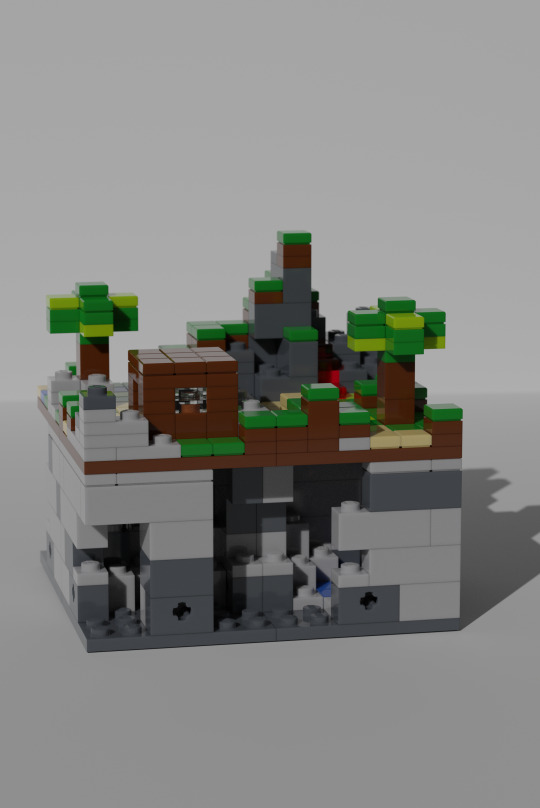
remember back in week 2 (2018) where i tested out the differences in rendering between stud.io 1 and 2? i tested out the mecabricks extention for Blender to render some digital bricks.
this took way too long to setup and render, so i decided to not use blender for rendering after that (escpecially after the win11 updated fucked with my graphics card)


another mandalorian s2 set MoC. din djarins N1 starfighter, based on the last N1 set we had back in 2015. i think these proportions aren't good, but a bit better than the official set. (its still too big though)


the Horizon: forbidden west set was also teased/revealed around that time, so i decided to make a diorama with just the watcher (and one with a corrupted one) that would be a bit more managable in both cost and size than the tallneck.
i still got the tallneck, becauce those robot dinos are cool as hell and i want to support video game based sets, even though i am a big supporter of the concept that LEGO should make more original themes instead of big and expensive licensed sets (like rivendell....)


some greebles inspired by the ones on the Icons (formerly master builder) "theme" of sets, also my header image for tumblr.
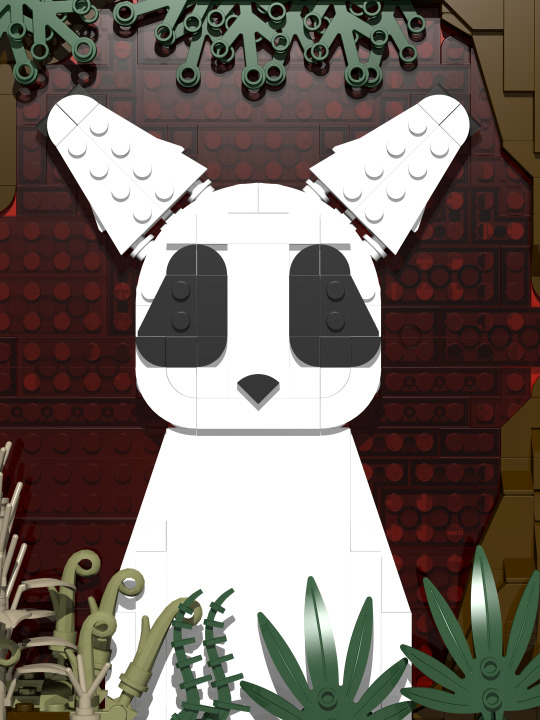
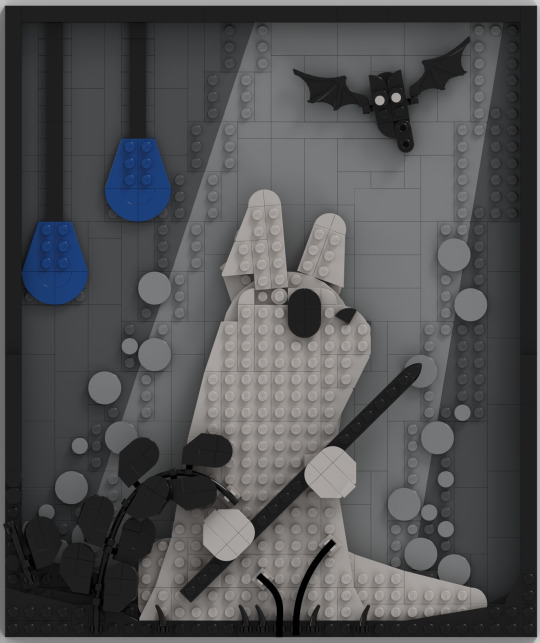
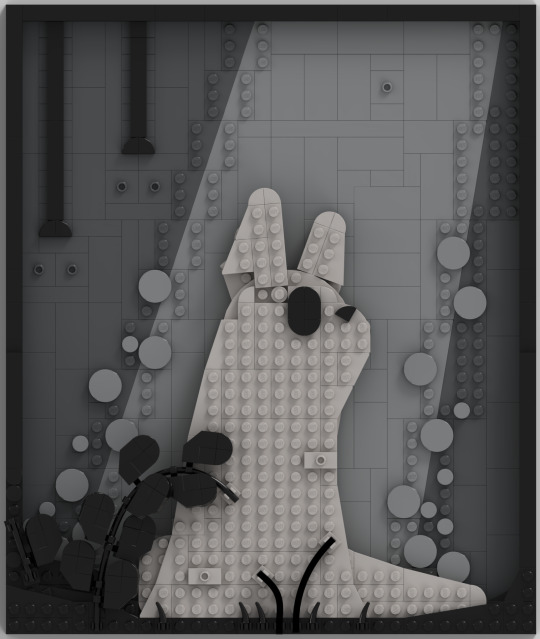
back in 2017 (week one) i made The Slugcat Portrait mosaic, and i decided in 2022 that i would remake it to be more in line with the way i would built with bricks at that time. i think i improved wuite a bit.
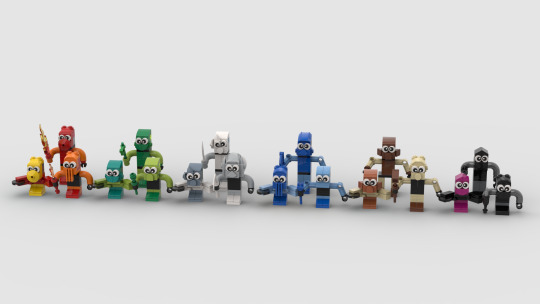
i like the 90 years of play tahu, even if his design was considered to be controversial, so i decided to make the full 2001 set lineup for bionicle. i think they turned out pretty good, but i find it a bit annoying that the maccaroni piece does not exist in tan or medium blue (a dicontinued colour)

anyone remeber Valley? the momentum-based FPS platformer? no? it wasn't really mind-blowing, but i still enjoyed the movement and flow of the game. i also always wanted to try out the Legoland Miniland style of character building. this was the perfect opportunity to combine both of these things.
i think the proportions might be a bit off, but i still like this little desk friend
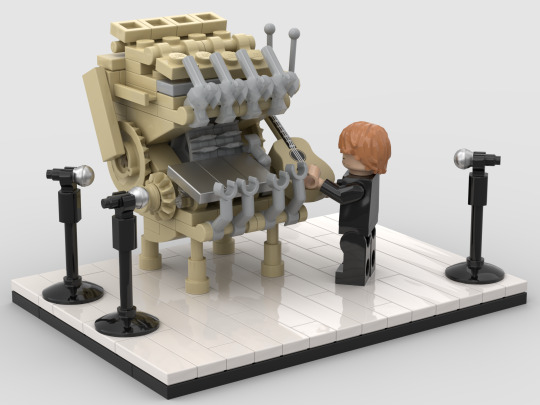
someone asked me on twitter to send them the instructions for my marble machine MoC (as seen in week 7), but i didn't want to give them such and outdated build, so i re-designed it to be more up to date.
they ended up giving me about 14 $ for these instructions, which made me pretty happy.

i tried to make a micro-scale version of the exo-force set 7701 Grand Titan. i really dislike the way this one turned out.
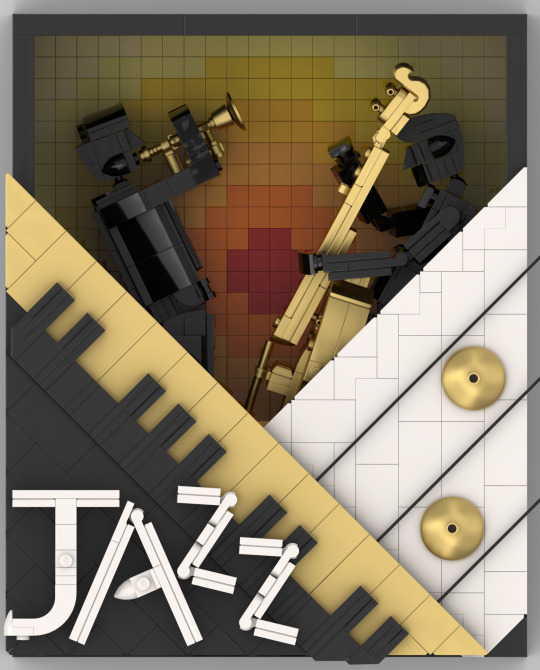
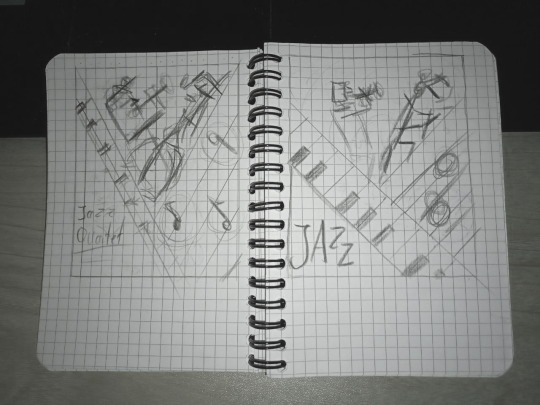
Lego Ideas had yet another contest. this one was about designing a poster for the then new 21334 Jazz Quartet. i called this one "Golden Sounds" and it is the first mosaic-type MoC that i made where i first sketched it out to kinda figure out how i wanted it to look.
i like the way this one turned out, but i think i should've built it in such a way that the colours in the background wouldn't be as dim.

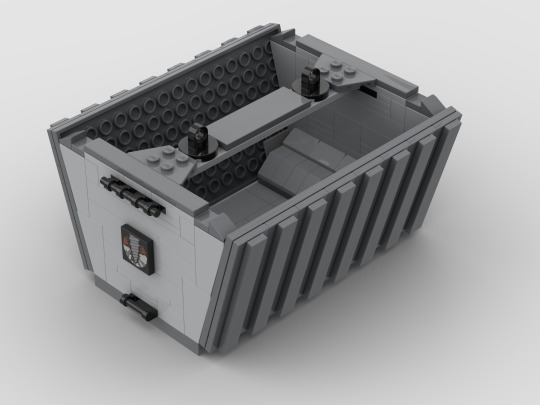
remember last week when i said i wanted to make more Rock raiders MoCs? turns out i did. a lot too.
this VTOL-style transport vehicle was kinda inspired by those industrial transport helicopters and was supposed to be some sort of reimagining of 4980 tunnel transport. i think it's a bit too clunky and a bit too skinny at the same time. not my favourite.
also there's a modular open container (is that what they're called?) that can be fixed under the vehicle. (as well as the room container that you'll see next)
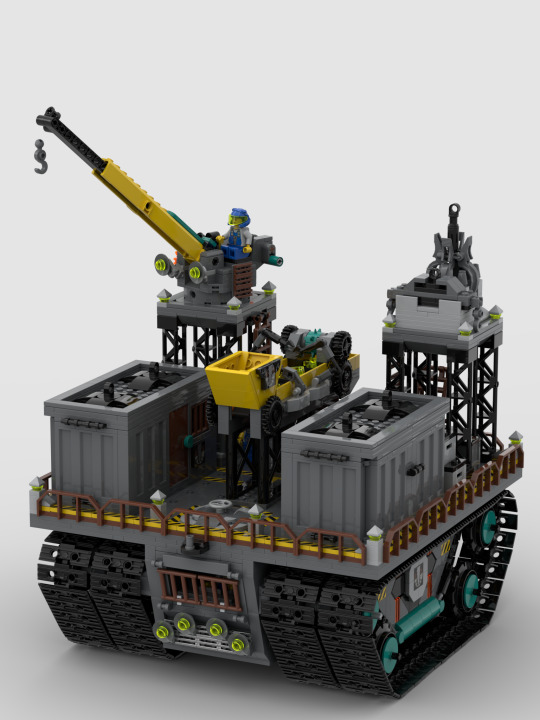
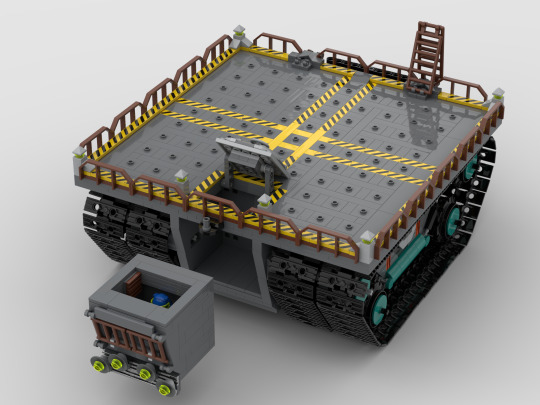
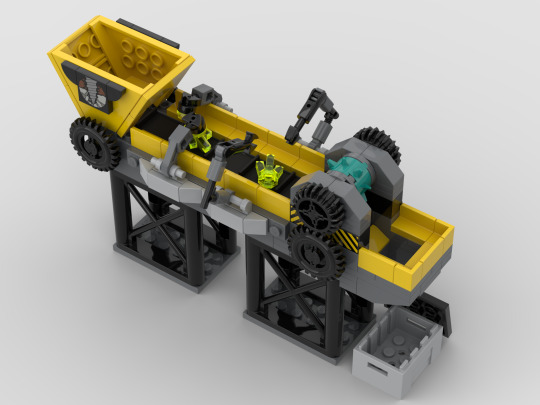
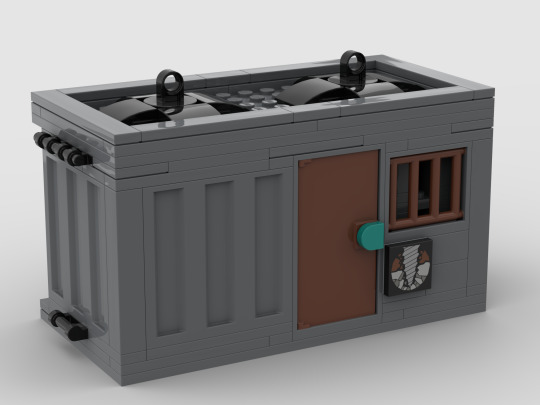
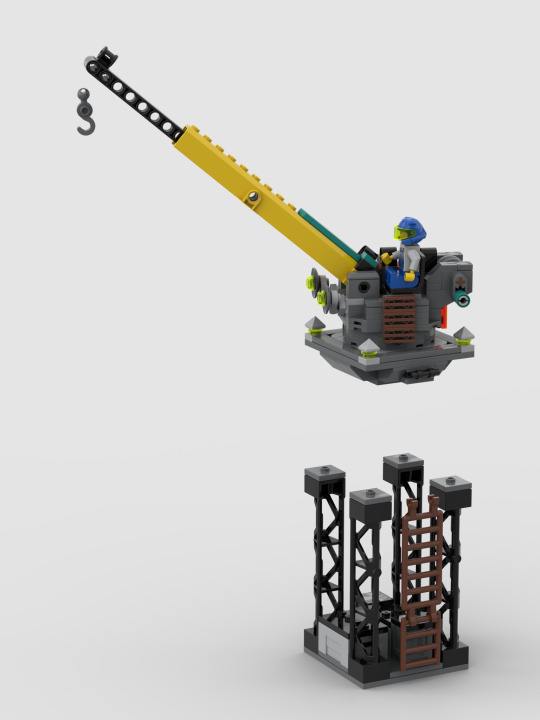
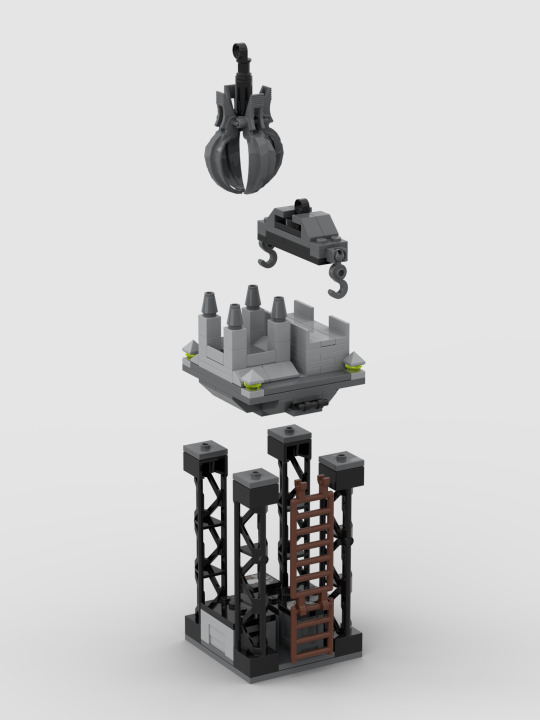
Modular bases are so cool you guys. this one is inspired by 4990 Rock Raiders HQ and those big old moving platforms Nasa uses. it could be controlled with a motor, has a removable cockpit (with an access hatch) and the platform has a lot of room for modules. like the crystal refinery, the room container, the high platforms, the crane and the crane attachment holder.
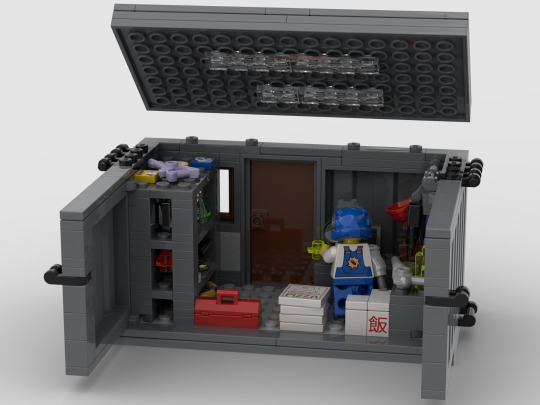


here are a few variants for the room container: an artifact storage with workbench, a small break room and a laboratory. i like those and i might do more in some time in the future. idk yet.

my take on the rock monsters. some crystal infested/energized Fauna.
first some bipedal designs (the left one is a modded version of a deviant form an eternals sets) that could be more agressive carnivore types.
in the middle are some quadrupedal guys that could be a bit less agressive and even friendly. Left is a modded version of my SCP 860 creature from week 4 (which was based on either an legendary beast from Chima or a dragon from elves) and the right one is a recolour from the fluffy-tailed Hog from my satisfactory series from week 3
and lastly, some insectoid designs, a kind of beetly creature and two ants, one of them with wings. these could be some sort of neutral (like in minecraft) swarm that might be a problem for buildings and cocky miners.
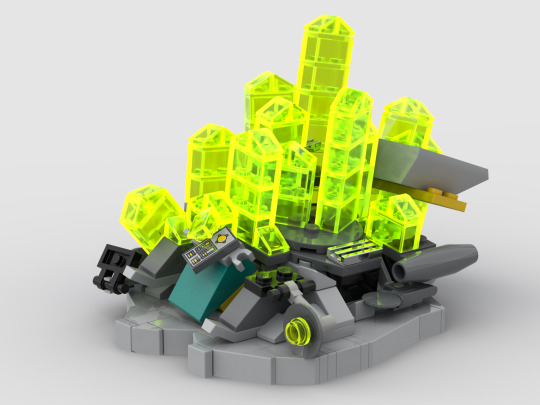
this is probably my favourite of my Rock Raiders Builds from 2022. it's 4920 rapid rider built with modern pieces that has been overtaken by the energy crytals. it can be fully freed from crystal and reassebled, which is nice.
we'll see another rapid rider next week...
first week last week final week
#lego#lego moc#lego minecraft#the mandalorian#horizon zero dawn#rain world#valley#wintergatan#marble machine#exo-force#lego jazz quartet#90th anniversary tahu#rock raiders
7 notes
·
View notes